Reporting data to the Incomes Register: international situations
- Validity
- - 12/19/2018
1 Obligation to inform in international situations
1.1 General information on reporting international information
The income paid to an income earner for work performed abroad and other information must be reported to the Incomes Register on an earnings payment report when the information is required for taxation purposes or when the income earner is insured in Finland. Correspondingly, the income paid for working in Finland to an employee who came to Finland from abroad is reported using an earnings payment report.
Income data must be reported to the Incomes Register in international working situations whenever the payer has an obligation to inform some data user using the Incomes Register. For example, if the income earner is insured in Finland, the payer has an obligation to inform the Incomes Register for the use of earnings-related pension providers and other social insurance providers. In such a situation, it does not matter whether the income is paid by a foreign or a domestic employer or where the work is performed.
A Finnish employer must report information to the Incomes Register on an earnings payment report in the following international situations:
- Income paid for working abroad (to persons living abroad and in Finland).
- Income paid for working in Finland to an income earner coming to Finland from abroad to work .
- Wages paid by a foreign group company for working abroad, when a Finnish employer has posted an employee abroad and the employee is insured in Finland.
- Wages for insurance purposes agreed for the work abroad.
- Additional information on the work abroad for the Tax Administration (the so-called six-month rule).
- Additional information on work in a Nordic country for the Tax Administration.
1.2 Foreign employer
A foreign employer is also obligated to report information to the Incomes Register on wages it has paid. Furthermore, a foreign employer who leases employees to a service recipient in Finland must submit information to the Incomes Register for taxation purposes, for example concerning the employee's work in Finland
In taxation, a company that has not been established in accordance with Finnish law or that has a registered domicile elsewhere than in Finland will be considered a foreign employer. A person who acts as an employer and does not live in Finland is also deemed to be a foreign employer (non-resident taxpayer).
If, with regards to income taxation, a foreign company has a permanent establishment in Finland, it must register with the Tax Administration's Employer Register if it pays wages to a permanent establishment. In such a case, the employer has the same employer obligations in taxation as a Finnish employer, and it must submit information to the Incomes Register in the same way as a Finnish company.
A foreign company that does not have a permanent establishment in Finland as regards income taxation, but that pays wages for work performed in Finland, can register with the Employer Register if it so desires. In that case, the company will have the same employer obligations in taxation as Finnish companies. However, the employer will submit the data to the Incomes Register using not only income types but also additional income earner data entries; see the section Reporting obligation of a foreign employer later in this document.
A foreign employer that does not have a permanent establishment in Finland as regards income taxation must submit an earnings payment report to the Incomes Register in the following situations:
- Income is paid to an income earner working in Finland, and
- the income earner is insured in Finland;
- the income earner stays in Finland for more than six months, even if they are not insured in Finland;
- the employee is a leased employee who is a non-resident taxpayer, and Finland has the taxing right to the wages according to a tax treaty between the employee's country of residence and Finland.
- An income earner working abroad is paid income, and the income earner is insured in Finland.
In these situations, the information must always be submitted whether the company is registered with the Employer Register or not.
Furthermore, a foreign employer who leases an employee coming from abroad to a service recipient in Finland must submit an employee leasing notice.
For more detailed instructions on reporting for foreign employers, see Section 4, Reporting obligation of a foreign employer.
1.3 Representative of a foreign employer
A foreign employer is obligated to submit an earnings payment report and an employer's separate report to the Incomes Register if the employer is registered in the Prepayment Register. If the employer is not registered in the Prepayment Register, a representative of the foreign employer has a secondary obligation to report the information required for taxation to the Incomes Register. If, however, the representative does not report the information, it must be reported by the foreign employer. Provisions on the representative have been laid down in Section 8 of the Act on Posting Workers.
The representative is obligated to report the following data to the Incomes Register on behalf of the employer (Section 15.1 of the Tax Procedure Act):
- The wages paid by a foreign employer for work performed in Finland when a foreign employee leasing company has leased an employee to a service recipient in Finland and when the tax treaty between the employee's country of residence and Finland does not prevent Finland from taxing the wages.
- Wage income paid by a foreign employer when the wage earner stays in Finland for a period exceeding six months.
Furthermore, the representative must submit an employee leasing notice when the employee begins work in Finland. The employee leasing notice must include information on the estimated duration of the leased employee's work and the amount of wage, and the service recipient, when the tax treaty between the employee's country of residence and Finland does not prevent Finland from taxing the employee's wages.
Provisions on the representative's obligation to report the above-mentioned information are laid down in Section 15a of the Tax Procedure Act.
However, a foreign employer always has a reporting obligation to insurers when the income earner must be insured in Finland regardless of whether the employer has a representative or not.
1.4 Income earners with resident and non-resident tax liability
The payments made are reported to the Incomes Register on an earnings payment report. The report and the income types are the same for all income earners, both resident and non-resident taxpayers. Resident and non-resident tax liability are information affecting taxation. They have no effect on the obligation to provide insurance.
Persons whose residence and home are in Finland or who reside in Finland for more than six months consecutively, are deemed resident taxpayers. As a rule, a Finnish citizen who has moved abroad is considered to be a resident taxpayer for three calendar years following the year of the move abroad.
Persons whose residence and home are abroad, and who do not reside in Finland for more than six months consecutively, are deemed non-resident taxpayers. A report must be submitted of payments made to a person who is a non-resident taxpayer, regardless of whether tax at source must have been collected or tax withheld from the payment, or whether the person is insured in Finland. Such a report must also be submitted for compensation paid to a non-resident taxpayer for work performed abroad.
A company is deemed to be a non-resident taxpayer if it has not been established in accordance with Finnish legislation, or if its registered domicile is not Finland. Non-wage compensation for work paid to a company that is a non-resident taxpayer (other than a natural person) is reported to the Incomes Register only if tax at source has been collected from the income. If the payment made to the company is compensation for use (royalty), it must always be reported to the Incomes Register.
The Income Tax Act also includes provisions on resident tax liability that apply to certain special groups, such as persons working for Finland's foreign representative offices or international organisations.
For more information on the tax liability status, see the Tax Administration Guidelines Resident and non-resident tax liability.
1.5 Additional income earner and payer details in international situations
In international situations, income is reported using the same income types of the earnings payment report regardless of whether the income earner is a resident or non-resident taxpayer. If the income earner is a non-resident taxpayer, the following data must also be included in the income earner's details: Non-resident taxpayer: Yes.
With regard to the following special groups, additional income earner details or payer details must be provided:
- wages paid under the act governing the taxation of key employees;
- wages paid for frontier work (Nordic situations);
- wages or fees paid to an athlete;
- wages or non-wage compensation for work paid to an artist; and
- wages paid by a specialised agency.
The reporting method related to these special groups is described in more detail in Section 5, Special situations.
As the additional payer details, select Foreign group company as the payer type when a foreign group company is paying the wages of an employee who has been posted abroad but is insured in Finland. The information is provided by the Finnish company who posted the employee. Furthermore, the Person working abroad data must be provided as an additional income earner detail. For more details on the reporting, see Section 2.3.2, Wages for insurance purposes are determined, wages are paid by a foreign group company (resident taxpayer) and 2.6.4, Foreign group company pays the wages (non-resident taxpayer).
When a public sector organisation pays income to a non-resident taxpayer, the additional payer details must indicate that the payer is a public sector organisation. This data is required for international exchange of information.
1.6 Currency conversion
The data is reported to the Incomes Register in euros. If the payment was made in some other currency, the payment must be converted into euros using the ECB's reference exchange rate valid on the payment date (Bank of Finland > Exchange rates). If the payment is reported in the Incomes Register before the payment date, for example in connection with a payroll run, the income amount reported is converted using the reference exchange rate valid on the reporting date in question.
1.7 Customer identifiers
Payer's customer ID
The payer must report the data to the Incomes Register primarily using a Finnish Business ID or Personal Identification Number.
If the payer does not have a Finnish customer identifier, the data should be reported using a foreign identifier. This also requires the entry of further identifying and contact details, such as name and address. If the payer has both a Finnish and a foreign identifier, report both identifiers.
Income earner's customer ID
The income earner's data must be reported to the Incomes Register primarily with a Finnish Personal Identification Number. For a person living abroad, the foreign Tax Identification Number or personal identification number must also be disclosed. If the income earner has both a Finnish and a foreign identifier, report both identifiers.
If the income earner does not have a Finnish Personal Identification Number, report their date of birth, gender and address. It is possible to report the address in both Finland and the country of residence to the Incomes Register. For an income earner who is a non-resident taxpayer, the country of residence, the Tax Identification Number (TIN) of the country of residence, if the identifier is in use in the non-resident taxpayer's country of residence, and the contact information in the country of residence must also always be reported.
2 Reporting income paid for work abroad
2.1 Social insurance contributions and provision of insurance
Under certain conditions, an income earner working abroad can be covered by Finnish social security. In such a case, social insurance contributions must be paid to Finland based on the income earner's income. The payer must therefore also report the necessary information to the Incomes Register.
An employee leaving from Finland and working abroad is insured in Finland if
- Finnish legislation is applied to the employee based on the EU social security regulations and the employee has an A1 certificate from Finland; or
- Finnish legislation is applied to the employee based on a social security agreement and the employee has a certificate of the applicable legislation.
For further information on the social insurance contributions in different situations, see the insurers' own websites:
- earnings-related pension insurance: the payer's earnings-related pension provider or the Finnish Centre for Pensions (www.etk.fi)
- unemployment insurance: Unemployment Insurance Fund (www.tvr.fi)
- accident and occupational disease insurance and employee's group life insurance: the payer's accident insurance company or the Workers' Compensation Center (www.tvk.fi)
- employer's health insurance contribution and employee's health insurance contribution: Tax Administration (www.vero.fi) and Kela (www.kela.fi).
If there is no social security agreement between Finland and the country of work, whether or not the income earner is covered by Finnish social security is determined by national legislation. It may be possible in such cases that the employee is insured both in Finland and the country of work. Finnish insurance coverage is separately determined for earnings-related pension, unemployment and occupational accident insurance, and the social security handled by Kela.
When a person is posted abroad, wages for insurance purposes must be determined for him/her. The employer's and the employee's social security contributions are determined based on this. Wages for insurance purposes are calculated wages that would have to be paid, if work corresponding to work performed abroad were to be performed in Finland. Different actors have different rules on when wages for insurance purposes are used to determine the social insurance contributions, and when actual wages paid are used instead.
Wages for insurance purposes do not need to be determined in all situations, for example if the posting abroad is shorter than six months in duration. In such situations, the social insurance contributions are paid based on the actual wages. For more information, see the pensions act service (www.tyoelakelakipalvelu.fi).
The six-month rule for taxation is different than the six-month inspection period used in determining the wages for insurance purposes. The actual work period abroad is considered in determining the wages for insurance purposes. If the work period exceeds six months, wages for insurance purposes must be determined.
2.2 The income on which insurance contributions and the income on which taxation is based are different
In some situations related to working abroad, the income on which some social insurance contributions are based is different than the income on which taxation is based. In these situations, wages for insurance purposes must be reported to some Incomes Register data users and the actual wages paid to some.
In situations where wages for insurance purposes have been determined but the actual wages paid are used as the basis for taxation, the Tax Administration and Kela will use the actual wages paid as the basis for taxes and contributions.
In these situations, the employer's and the employee's health insurance contributions are determined by the actual wages paid when the income is taxed progressively (income received by both resident and non-resident taxpayers). In such a case, include the following data in connection with the wages for insurance purposes: Insurance information type: Subject to health insurance contribution, Grounds for insurance contribution: No. Based on this information, the Tax Administration and some payers of benefits are informed of the wages for insurance purposes not being the grounds for the health insurance contributions and some benefits.
However, the pension and unemployment insurance contributions are paid based on the wages for insurance purposes. The accident and occupational disease insurance contributions are determined based on the wages for insurance purposes, but compensations for loss of earnings paid based on the insurances are determined based on the actual wages paid.
Situations where the income on which social insurance contributions are based may be different than the income on which taxation is based include:
- a resident taxpayer works abroad;
- wages for insurance purposes are determined, but the six-month rule does not apply to the wage income (Section 2.3.1.2);
- wages for insurance purposes are determined and the wages are paid by a foreign group company, but the six-month rule does not apply to the wage income (Section 2.3.2.2);
- a non-resident taxpayer works abroad;
- the income earner is insured in Finland, but
- the income is not taxed in Finland (Section 2.6.1.1);
- the income is taxed in Finland, the income is taxed according to the Tax at Source Act (Section 2.6.1.2);
- income is taxed in Finland, income is taxed according to the Tax Procedure Act (so-called progressive taxation of a non-resident taxpayer) (Section 2.6.1.3).
- the income earner is insured in Finland, but
In these situations, the data can be reported to the Incomes Register in one report when the payer uses reporting method 1 for reporting monetary wages. If the payer uses reporting method 2, the data must be reported to the Incomes Register in two reports. There are examples of data submitted using the different reporting methods in the above-mentioned sections.
Reporting method 1
When the payer reports the data to the Incomes Register using reporting method 1, the following income types must be reported:
- Wages for insurance purposes
- Total wages.
In addition to these income types, the payer must report the following data related to the Wages for insurance purposes income type: Six-month rule is applicable: No and Insurance information type: Subject to health insurance contribution, Grounds for insurance contribution: No. Furthermore, the Insurance information type data group connected to the Total wages income type must be used to report the social insurance contributions not paid based on the Total wages income type, but paid on basis of the wages for insurance purposes instead, for example:
- Insurance information type: Subject to earnings-related pension insurance contribution, Grounds for insurance contribution: No
- Insurance information type: Subject to accident and occupational disease insurance contribution, Grounds for insurance contribution: No
- Insurance information type: Subject to unemployment insurance contribution, Grounds for insurance contribution: No
If the Insurance information type data group is not used to report that the contributions in question are not paid for the Total wages income type, the social insurance contributions are determined twice, based on both the wages for insurance purposes and the total wages.
Reporting method 2
As a rule, income types reported using reporting method 2 include the data on to which social insurance contributions they are subject by default. By default, the Time-rate pay income type is subject to all social insurance contributions. Insurance information type is income-type-specific, but it cannot be connected to the Time-rate pay income type.
In order for the social insurance contributions to not be levied twice, based on both the wages for insurance purposes and the time-rate pay, the payer must submit two reports to the Incomes Register:
- The wages for insurance purposes are reported in its own report. For the Wages for insurance purposes income type, the following data must be submitted: Six-month rule is applicable: No and Insurance information type: Subject to health insurance contribution, Grounds for insurance contribution: No.
- The Time-rate pay income type is reported in its own report. In addition to the Time-rate pay income type, the following data must be reported:
- Type of exception to insurance: No obligation to provide insurance (earnings-related pension insurance)
- Type of exception to insurance: No obligation to provide insurance (unemployment insurance)
- Type of exception to insurance: No obligation to provide insurance (accident and occupational disease insurance).
Type of exception to insurance data applies to the entire earnings payment report, and the data cannot be connected to an individual income type. Were the data on the wages for insurance purposes and time-rate pay as well as the type of exception to insurance data submitted in the same report, the social insurers would not receive information on the grounds for the insurance contributions.
2.3 A Resident taxpayer works abroad
The so-called six-month tax exemption rule may apply to the wages of an employee working abroad (Section 77 of the Income Tax Act). In such a case, the wages paid are tax-exempt in Finland, and only social insurance contributions are paid from the income if the income earner is covered by Finnish social security.
Pay for work performed abroad is tax-exempt in Finland if all of the following conditions are met:
- the person's stay abroad is caused by said work;
- the duration of the stay is consecutively at least six months;
- the person does not stay in Finland for more than six days per working month on average; and
- the country of work has a taxation right to the income in question under a tax treaty if there is an agreement on income taxation between Finland and the country of work.
If the six-month rule applies to the wage income and the income earner is insured in Finland, the employer will perform a so-called minimal withholding (employee's health insurance contributions) based on the wages for insurance purposes automatically, and there is no need to change the tax card. The amount of the minimal withholding is confirmed annually by a decision of the Tax Administration. Additionally, the employer collects the employee's share of the earnings-related pension and unemployment insurance contributions from the wages. The payer reports Person working abroad as an additional income earner detail to the Incomes Register. This data is used always when an employee insured in Finland works abroad as an employee posted by a Finnish employer.
If a Finnish company posts an employee abroad and, for example, a foreign group company pays the employee's wages and the employee is insured in Finland, the Finnish company pays the employer's social insurance contributions (including the employer's health insurance contribution) and reports them to the Incomes Register. The employee's health insurance contribution is levied from the employee as back tax. In these situations, the Finnish company that posted the employee reports its own details in the payer details and submits Foreign group company as other payer details, and Person working abroad as additional income earner details.
When the employer applies the six-month rule of the Income Tax Act to the wage income, the following data must be reported to the Incomes Register in addition to the income type: Six-month rule is applicable: Yes and the country code of the country of work. In situations where wages for insurance purposes have been determined for an employee, but the six-month rule is not applicable, the following data must be submitted: Six-month rule is applicable: No. For more details on these situations, see Section 2.3.1.2.1 (Finnish employer pays the wages) and Section 2.3.2.2 (a foreign group company pays the wages) of these instructions. If no wages for insurance purposes have been determined for the duration of the work period abroad and the six-month rule is not applicable to the wage income, the Six-month rule is applicable data does not need to be submitted.
When an employer does not withhold taxes because the six-month rules applies to the income, the employer must submit complementary information required by the Tax Administration to the Incomes Register; see Section 2.4, Additional information on work abroad.
When an employer posts an employee to another Nordic country, the employer must submit complementary information required by the Tax Administration to the Incomes Register; see Section 2.4, Additional information on work in a Nordic country.
See below for descriptions of different situations based on whether the income is taxable in Finland or not and whether insurance contributions are paid from the income to Finland or not. A Finnish payer's obligations in situations where the payment of wages is transferred to a foreign group company are described in Sections 2.3.2 (income earner is a resident taxpayer) and 2.6.4 (income earner is a non-resident taxpayer).
2.3.1 Wages for insurance purposes are determined
2.3.1.1 The six-month rule applies to the entire pay period
Example 1: A Finnish employer has posted an employee to Germany to work for two years. The employee has an A1 certificate issued by the Finnish Centre for Pensions, and the amount of wages determined for her for insurance purposes is EUR 4,000 per month. The six-month rule applies to the income throughout the pay period. The employer's and the employee's social insurance contributions are paid based on the wages for insurance purposes. The employee's health insurance contribution (so-called minimum withholding) is reported as withholding, although tax does not otherwise need to be withheld from the wages.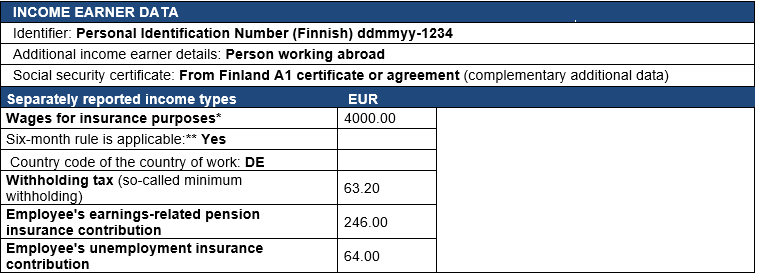
*The wages for insurance purposes can be reported monthly, no later than on the fifth day of the calendar month following the work.
**The six-month rule is applicable data can be connected to an individual income type.
In addition to the above-mentioned identifying and income data, the payer must submit complementary additional data on the work abroad required by the Tax Administration as information connected to the work abroad; see Section Additional information on work abroad (six-month rule).
2.3.1.2 Six-month rule is not applicable
When the six-month rule is not applicable to the income earner's foreign wages but wages for insurance purposes have been determined for him/her, the employer may report the data in one earnings payment report when it uses reporting method 1 for reporting monetary wages. If the employer uses the reporting method 2, the employer must submit two reports to the Incomes Register.
For more information on the procedure, see Section 2.2, The income on which insurance contributions and the income on which taxation is based are different.
When wages for insurance purposes have been determined for the employee but the six-month rule is not applicable to the income, the payer must report the following data in addition to the income type: Six-month rule is applicable: No.
2.3.1.2.1 Income is entirely taxed in Finland
Example 2: A Finnish employer has posted an employee to Sweden to work for one year. The Finnish Centre for Pensions has issued him an A1 certificate from Finland. The employee's wages for insurance purposes have been determined to be EUR 5,300 per month. The employee is paid EUR 5,000 per month in wages. The income earner stays in Finland during his work to the extent that the six-month rule is not applicable to his wages. The employee's withholding rate on the tax card is 33%.
The employer's and the employee's earnings-related pension and unemployment insurance contributions, and the employer's accident and occupational disease insurance contributions are paid based on the confirmed wages for insurance purposes (EUR 5,300). However, taxes are levied from the employee's actual wages (EUR 5,000); correspondingly, the employer's health insurance contribution is paid based on the actual wages paid. Tax is withheld (EUR 5,000 x 33% = EUR 1,650) based on the actual wages paid. The employee's health insurance contribution is included in the withheld tax.
Reporting method 1
If the data is submitted using reporting method 1, it can be reported in one earnings payment report as follows: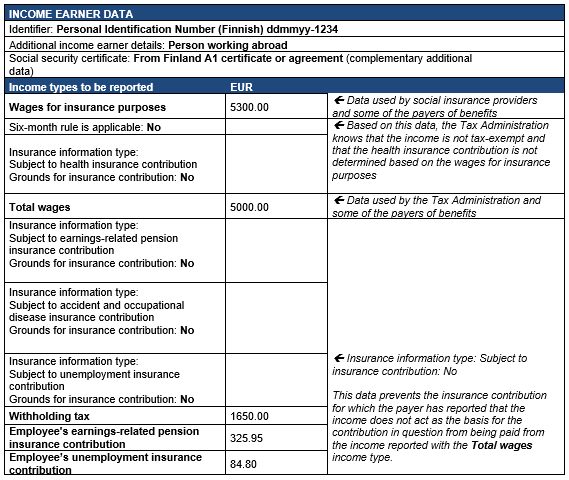
Based on the submitted data, the earnings-related pension, unemployment, and accident and occupational disease insurance contributions are paid, based on the wages for insurance purposes (EUR 5,300), but the employer's health insurance contribution is paid based on the actual wages paid (EUR 5,000). Furthermore, the income earner is taxed based on the actual income paid.
Reporting method 2
When reporting method 2 is used, the data must be submitted in two earnings payment reports. The wages for insurance purposes, used as the basis for some social insurance contributions, are reported in one report, and the actual paid wages for the Tax Administration and the determination of the health insurance contribution in another report.
Reporting the wages for insurance purposes: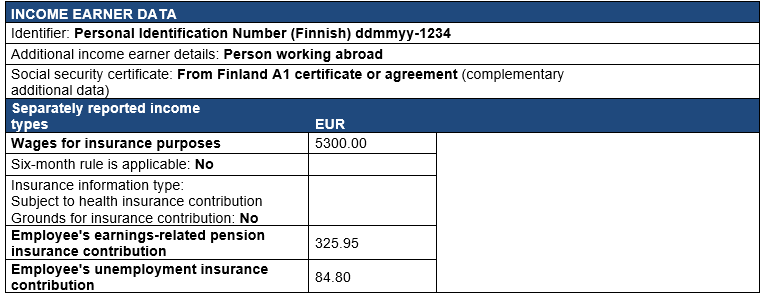
Reporting the actual wages paid:
2.3.1.2.2 The country of work taxes the income
If a permanent establishment in the country of work is established for the payer in the country of work as regards income taxation, the payer must usually collect taxes from the income earner's wages for the country of work, too. If the six-month rule is not applicable, the payer must withhold tax in Finland. However, the income earner may apply for a change to his/her tax card, in which case the taxes paid abroad can be taken into consideration in the withholding rate.
The payer can report the taxes collected from the income earner's wages and paid to the country of work using the separately reported income type, Tax paid abroad. This data is voluntarily submitted complementary additional data. In other regards, the data is reported in the same way as in the previous example.
Although the payer reports the tax paid abroad to the Incomes Register, the income earner must request the elimination of any double taxation in his/her taxation; he/she must also report the tax paid abroad in the tax return.
2.3.1.3 The six-month rule is applicable in the middle of a pay period
If the wages for insurance purposes begin to be applied in the middle of a month, the wages for insurance purposes are divided by 30.33 when the pay period is one month. The resulting number is divided by the number of days during which the wages for insurance purposes apply.
Example 3: The amount of wages for insurance purposes is EUR 5,000 per month. The work abroad begins in the middle of the month in such a manner that the wages for insurance purposes apply for 13 days. Regular wages are used for the other days of the month. (EUR 5,000 / 30.33) x 13 = EUR 2,143.09, which is the amount of the wages for insurance purposes for the partial month (13 days).
The following examples describe the reporting procedure in a situation where the employee's work abroad begins in the middle of a pay period and wages for insurance purposes are determined for him.
Example 4: Payer uses a one-month pay period. On 15 April, the employee begins work that will last one year in Great Britain. The six-month rule is applicable to his wages immediately from the beginning of work. The Finnish Centre for Pensions has issued him an A1 certificate from Finland. The income earner's monthly wages are EUR 3,400, and the amount of wages determined for him for insurance purposes is EUR 3,800 per month. The employee's wages are paid from Finland during the posting abroad. On his tax card, the withholding rate is 20%.
In the beginning of the month, the employer pays the social insurance contributions based on the actual wages paid and at the end of the month based on the wages for insurance purposes. There are 30.33 tax days in one month. The amount of wages paid is (EUR 3,400 / 30.33) x 14 days = EUR 1,569.40. The amount of wages for insurance purposes is (EUR 3,800 / 30.33) x 16 days = EUR 2,004.62. The employer withholds tax (EUR 313.88) from the part of the wages (EUR 1,569.40) that is taxed in Finland, and withholds the minimum withholding (EUR 31.67) from the amount of wages for insurance purposes.
In this kind of a situation, the payer must submit two reports to the Incomes Register: the wages for the first part of the month must be reported in one earnings payment report and the wages for the second part of the month in another.
Reporting the wages for the start of the month (employer works in Finland):
Reporting the wages for the end of the month (employee works abroad, six-month rule is applicable, wages for insurance purpose have been determined):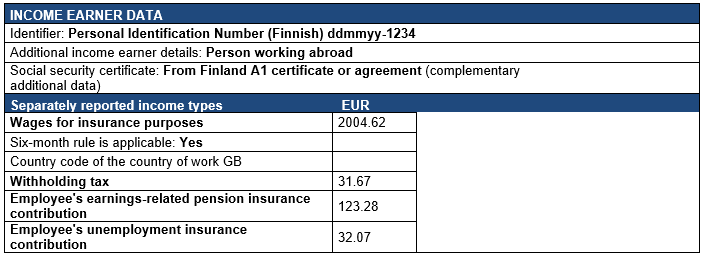
2.3.1.4 Insurance information changes in the middle of a pay period, the six-month rule is applicable to a part of the wages for the pay period
The insurance information applies to the entire report. If the information changes in the middle of a pay period, the payer must submit two different earnings payment reports to the Incomes Register.
Example 5: Payer uses a one-month pay period. An employee moves abroad to work on 15 April. The six-month rule is applicable to the work abroad. The employee is not insured in Finland for the duration of the work abroad. The employee's monthly wages are EUR 3,400 and his wages are paid from Finland during the posting abroad. The withholding rate on the tax card is 20%.
The employer pays the social insurance contributions based on the actual wages paid for the start of the month. There are 30.33 tax days in one month. The amount of wages paid is (EUR 3,400 / 30.33) x 14 days = EUR 1,569.40. The amount of withholding is EUR 313.88. The social insurance contributions are no longer paid to Finland for the end of the month. Neither is minimal withholding done, because the employee is not insured in Finland. The payer must submit two different earnings payment reports to the Incomes Register.
Reporting the wages for the start of the month (employee works in Finland and is insured in Finland):
Reporting the wages for the end of the month (employee works abroad, six-month rule is applicable, employee is not insured in Finland): The amount of wages paid is (EUR 3,400 / 30.33) x 16 days = EUR 1,793.60.
2.3.2 Wages for insurance purposes are determined, wages are paid by a foreign group company
If an employee posted abroad is insured in Finland, the employee's and the employer's social insurance contributions and other social insurance payments must be accrued in Finland even if the wages are paid by a foreign group company or another company where the Finnish company that posted the employee has authority. In these situations, the Finnish company that posted the employee pays the employer's health insurance contribution and other social insurance contributions (including the employee's shares of the pension and unemployment insurance contributions). The Finnish company is also obligated to report to the Incomes Register the information on the wages for insurance purposes, or the actual wages paid if the six-month rule is not applicable to the wage income.
In the reports submitted to the Incomes Register, the Finnish company reports its own details in the payer details, although the payer is in fact a foreign company. When a foreign group company pays the wages to an employee posted abroad who is insured in Finland, the Finnish company that posted the employee must submit the Foreign group company data as other payer details and the Person working abroad as an additional income earner detail.
The wages for insurance purposes can be reported to the Incomes Register monthly, no later than on the fifth day of the calendar month following the work.
2.3.2.1 Six-month rule is applicable
When the six-month rule is applicable to the wage income and the wages for insurance purposes have been determined, the employer's health insurance contribution and other social insurance contributions are paid based on the wages for insurance purposes. The withholding (so-called minimal withholding) of the employee's health insurance contribution does not accrue, because the wages are paid by a foreign company. Based on the data submitted to the Incomes Register, the Tax Administration determines the amount of the employee's health insurance contribution in final taxation, and it is paid as back tax.
Example 6: A Finnish company posts an employee to work in Italy for two years for its subsidiary. The Finnish Centre for Pensions has issued her an A1 certificate, and EUR 5,000 have been determined as her wages for insurance purposes. The wage payment is transferred to the Italian subsidiary.
Because the employee is insured in Finland, the Finnish company is obligated to pay the employee's health insurance contribution and other social insurance contributions to Finland, and to report the wages for insurance purposes to the Incomes Register. The Italian subsidiary collects the employee's share of the earnings-related pension and unemployment insurance contributions from the wages it pays and pays the contributions to the Finnish company.
The Finnish company reports to the Incomes Register the wages for insurance purposes and the employee's shares of the earnings-related pension and unemployment insurance contributions. Based on the wages for insurance purposes submitted to the Incomes Register, the Tax Administration determines the amount of the employee's health insurance contribution in the employee's final taxation, and it is paid as back tax.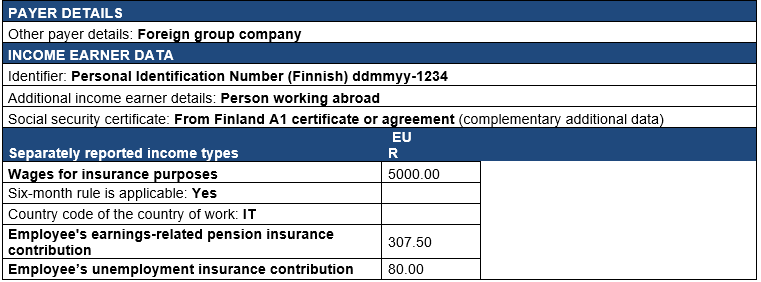
2.3.2.2 Six-month rule is not applicable
If the employee posted abroad is insured in Finland, but the six-month rule is not applicable to the income, the employer's and the employee's health insurance contributions are paid based on the actual wages paid. The employer's and the employee's earnings-related pension and unemployment insurance contributions, and the employer's accident and occupational disease insurance contributions are paid based on the wages for insurance purposes.
The actual wages paid are the basis of the employer's and the employee's health insurance contributions up to the amount in which the wages would be subject to withholding if the work had been performed in Finland. In other words, the payment obligation is not linked to the wages for insurance purposes. The Finnish company that posted the employee must request the necessary information on the wages paid from the foreign payer. The fringe benefit decision of the Tax Administration also confirms the value of foreign fringe benefits.
Because the six-month rule is not applicable to the income, the income is taxed in Finland. If a right to tax the wages is established for the country of work, the employee must request the elimination of double taxation in a tax return submitted to Finland.
If the Finnish and foreign company belong to the same group, the Finnish employer is obligated to report to the Incomes Register the wages paid by the foreign employer. At the same time, the employer may also report any taxes collected for the foreign country by the foreign employer.
The data can be submitted to the Incomes Register in one earnings payment report when reporting method 1 is used. When reporting method 2 is used, two reports must be submitted. For more information on the procedure, see Section 2.2, The income on which insurance contributions and the income on which taxation is based are different.
Example 7: A Finnish company posts an employee to work in Denmark for two years for its subsidiary. The Finnish Centre for Pensions has issued her an A1 certificate, and EUR 5,300 has been determined as her wages for insurance purposes. The wage payment is transferred to the Danish subsidiary. The amount of wages paid is EUR 5,000.
The employee spends her free time in Finland with her family. She stays in Finland so much that the six-month rule is not applicable to the income.
Because the employee is insured in Finland, the Finnish company is obligated to pay the employee's health insurance contribution and other social insurance contributions to Finland, and to report the data to the Incomes Register. The Danish subsidiary withholds the employee's share of the earnings-related pension and unemployment insurance contributions from the wages it pays.
Because the six-month rule is not applicable to the income, the income is also taxable in Finland. The double taxation is eliminated in Finland in accordance with the provisions of the tax treaty. Furthermore, the Tax Administration determines the amount of the employee's health insurance contribution in the final taxation based on the actual wages paid; the contribution is paid as back tax.
Reporting method 1
If the data is submitted using reporting method 1, it can be reported in one earnings payment report as follows: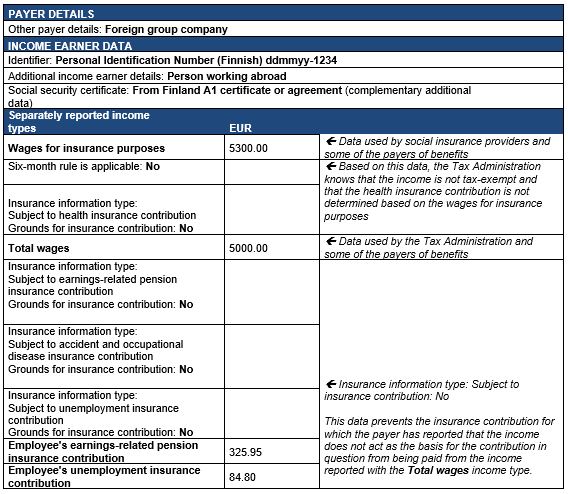
Reporting method 2
When reporting method 2 is used, the data must be submitted in two earnings payment reports. The wages for insurance purposes, used as the basis for the social insurance contributions, are reported in one report, and the actual paid wages for the Tax Administration and the determination of the health insurance contribution in another report.
Reporting the wages for insurance purposes: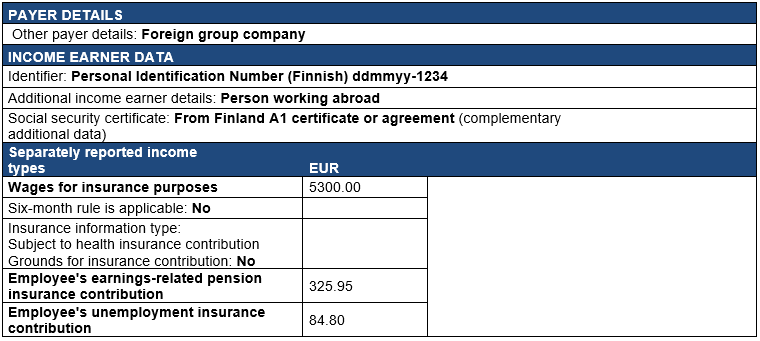
Reporting the actual wages paid: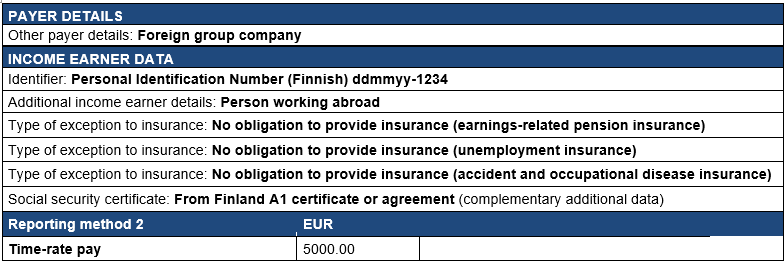
2.3.3 Income earner is not insured in Finland
2.3.3.1 Six-month rule is applicable
If a resident taxpayer working abroad is not insured in Finland and the six-month rule is applicable to the wages paid to him/her, the Finnish employer must report the income to the Incomes Register.
Example 8: A Finnish citizen has worked in Belgium for two years in the service of a local employer. The employee is a resident taxpayer in Finland. He moves to work for a Finnish company at a place of business located in Belgium. The amount of the wages is EUR 3,000. The six-month rule is applicable to the wage income. The employee is not covered by Finnish social security.
2.3.3.2 Six-month rule is not applicable
If the six-month rule is not applicable to the wages of a resident taxpayer working abroad, the income is taxable in Finland. The Finnish employer must withhold tax from the income to Finland in accordance with the stipulations of the tax card and report the data on the wages paid to the Incomes Register.
The payer must also use the Type of exception to insurance data to report that the social insurance contributions are not paid to Finland, for example: Not subject to Finnish social security (earnings-related pension, health, unemployment or accident and occupational disease insurance) As complementary data, the following can be reported: Social security agreement: To Finland A1 certificate or agreement.
2.3.4 Wage income subject to Seamen's Pensions Act and work abroad
The Seamen's Pensions Act does not include the concept of wages for insurance purposes. If a wage earner is subject to the Seamen's Pensions Act and the six-month rule is applicable, the payer reports the income according to the actual wages paid. The social insurance contributions are determined based on the wages paid.
2.3.5 Wages paid to an entrepreneur and the six-month rule
If an income earner who goes abroad to work is YEL-insured (pension insurance for the self-employed) and the six-month rule applies to the wages paid, the social insurance contributions are paid based on the YEL income from work. The income is reported to the Incomes Register as follows:

2.3.6 Incentives and the six-month rule
Income from an employee stock option may under certain conditions be tax-exempt under the six-month rule. If the conditions are met, the employer may apply the six-month rule when reporting the payment to the Incomes Register. For example, the employer must arrange reliable tracking of working days and, when reporting the employee stock option to the Incomes Register, check that the conditions of the income being tax-exempt have been fulfilled.
For more information on the conditions, see the Tax Administration Guidelines Taxation of employee stock options.
Example 9: On 1 May 2017, an employee working in Finland is given employee stock options the earnings period of which ends on 12 December 2018. In the service of his employer, he moves abroad starting on 17 November 2017. The six-month rule is applicable to both the wages and the stock options.
The employee exercises the options on 1 April 2019. He receives a benefit to the amount of EUR 90,000 from the options, divided into shares that are taxable and tax-exempt in Finland in the ratio of the working days. The share that is taxable in Finland is (200 / 600 x 90,000) EUR 30,000.
The employer cannot withhold tax from the value of the option benefit if the employer is not also concurrently paying taxable monetary wages to the employee. If the six-month rule applies to the monetary wages, tax does not need to be withheld from the share of the taxable employee stock option.
The benefit gained from the employee stock option is reported to the Incomes Register. The taxable share, EUR 30,000, is reported in the earnings payment report for April 2019 using the Employee stock option income type. The amount of option benefit to which the six-month rule is applicable, EUR 60,000, is reported using the Employee stock option income type, and in connection with it, the following data is submitted: Six-month rule is applicable: Yes and Country code of the country of work.
Reporting an employee stock option taxable in Finland:
Reporting an employee stock option to which the six-month rule is applicable:
2.4 Additional information on work abroad (six-month rule)
2.4.1 Information to be reported
The additional information on work abroad is reported to the Incomes Register for the purposes of the Tax Administration. The data can be submitted either in connection with earnings payment data or separately. The recommendation is, however, that the additional information on work abroad is submitted in a separate earnings payment report.
The data must be reported when the employer has applied the six-month rule as defined in Section 77 of the Income Tax Act to the wage income.
The wages earned from the work abroad are tax-exempt in Finland if the six-month rule as defined in Section 77 of the Income Tax Act is applicable to them. For more information on the taxation of work abroad, see the Tax Administration Guidelines Taxation of work abroad.
2.4.1.1 Withholding is not done to Finland (NT2 form data)
The employer may choose not to withhold tax from the wages it has paid for work abroad if the conditions of the six-month rule are fulfilled. When the employer does not withhold tax from the income earner's wages and starts applying the six-month rule, the employer must submit the information on the work abroad as NT2 form data.
The following data is then reported as NT2 form data:
- Country of work or countries of work, if several (mandatory data)
- District of work (voluntary data)
- Address in country of work (voluntary data)
- Stay periods in country of work (mandatory data)
- start date
- end date (estimated)
- Work periods abroad (mandatory data)
- start date
- end date (estimated)
- Pay burdens the result of a permanent establishment in the country of work (Y/N) (mandatory data)
- Country of work has right to tax the wages (Y/N) (mandatory data)
- Pay per month (voluntary data)
- Other remunerations and benefits (voluntary data)
2.4.1.2 Employer's report of periods of stay in Finland
The following data is submitted in the report:
- Stay periods in Finland (mandatory data)
- start date
- end date
- If the employee has not stayed in Finland at all during the time period for reporting, the payer must choose the following entry for Stay periods in Finland:
- Report contains no stay periods in Finland (Y/N)
2.4.2 The time of reporting data
Before the first payment of wages for work abroad, the employer must evaluate whether tax needs to be withheld from the payment to Finland. The employer must report the NT2 form data no later than on the fifth calendar day after the first wage payment date after tax was not withheld for the first time.
Even if tax is initially withheld to Finland, it may be later confirmed that the six-month rule applies to the wage income. Once the applicability of the six-month rule has been confirmed, the employer may choose not to withhold tax to Finland by its own decision. Additionally, the employer must then submit the NT2 form data to the Incomes Register.
In the employer's report of stay periods in Finland, the stay periods in Finland during the work abroad are reported. This data can be reported to the Incomes Register no later than by the end of January of the year following the year of payment. The stay periods in Finland are not usually known during the payment of wages; instead, the employee may report them to the employer afterwards. However, the data can also be submitted immediately after the work abroad has ended, or by pay period during the assignment. In the latter case, however, the employer must ensure that the data is submitted for the entire tax year.
2.4.3 Correction of information
If the additional information on work abroad has been reported incorrectly, the information must be corrected when the error is discovered.
If changes take place in the mandatory data (see Section 2.4.1.1) during the assignment, the corrections can be made no later than by the end of the January of the year following the tax year. If the country of work changes, new NT2 form data must be submitted if tax is still not withheld.
2.5 Additional information on work in a Nordic country
The Nordic Agreement Concerning the Collection and Transfer of Tax (97/1997), or the so-called TREKK Treaty, regulates information exchange and the transfer of taxes between the Nordic countries. For this purpose, the employer must submit the following information on work in another Nordic country to the Tax Administration:
- NT1 form data when tax is still withheld to Finland;
- NT2 form data when tax is not withheld to Finland.
Once the Tax Administration has received the NT form data, it sends the data to the tax authority of the country of work. The Tax Administration also provides the payer with a certificate of the withholding of tax to Finland when the income is still taxed in Finland.
For more information on reporting work in Nordic countries, see the Tax Administration Guidelines Taxation of work abroad.
2.5.1 Information to be reported
The additional information on work in a Nordic country is reported to the Incomes Register for the purposes of the Tax Administration. The data can be submitted either in connection with earnings payment data or separately. The recommendation is, however, that the additional information on work abroad is submitted in a separate earnings payment report.
When an employee works in another Nordic country, either the NT1 or NT2 form data must always be reported to the Incomes Register. Furthermore, when tax has not been withheld due to the applicability of the six-month rule, the stay periods in Finland must be reported in addition to the NT2 form data in the same way as described above in Section 2.4.
2.5.1.1 Tax is withheld to Finland (NT1 form data)
When an employee works in another Nordic country, tax must be withheld to Finland if:
- the employee's stay in the country of work does not exceed 183 days within a period of 12 months;
- the wages are paid by the Finnish employer;
- the wages do not burden the financial result of a permanent establishment in the country of work; and
- this does not constitute employee leasing.
When tax is withheld to Finland, the employer must submit the NT1 form data for the employee working in another Nordic country to the Incomes Register. The following data is reported as NT1 form data:
- Country of work (mandatory data)
- District of work (voluntary data)
- Address in country of work (voluntary data)
- Stay periods in country of work (mandatory data)
- start date
- end date (estimated)
- Principal in the country of work (mandatory data)
- identifier, name
- address
- Pay burdens the result of a permanent establishment in the country of work (Y/N) (mandatory data)
- Country of work has right to tax the wages (Y/N) (mandatory data)
2.5.1.2 Withholding is not done in Finland (NT2 form data)
When an employee is working in another Nordic country and tax is not withheld in Finland, information on not withholding must always be submitted as NT2 form data. Tax does not need to be withheld for two reasons:
- under Section 77 of the Income Tax Act concerning income for work abroad
- due to a tax treaty, when the six-month rule is not applicable, but the relief method is applied to the elimination of double taxation of the income.
The wages earned from the work in another Nordic country are tax-exempt in Finland if the six-month rule as defined in Section 77 of the Income Tax Act is applicable to them. Even if the six-month rule is not applicable, the country of work may establish a taxation right under the Nordic Tax Treaty. The taxation right may be established, for example, by the employer having a permanent establishment in the country of work. The possible double taxation will then be eliminated in the country of residence, i.e. Finland. If, however, the six-month rule is not applicable to the wage income, the employer may choose not to withhold tax only if the employee has applied for a change to his/her tax card.
In Nordic situations, the following data is reported as NT2 form data:
- Country of work or countries of work, if several (mandatory data)
- District of work (voluntary data)
- Address in country of work (voluntary data)
- Stay periods in country of work (mandatory data)
- start date
- end date (estimated)
- Work periods abroad (mandatory data)
- start date
- end date (estimated)
- Pay burdens the result of a permanent establishment in the country of work (Y/N) (mandatory data)
- Country of work has right to tax the wages (Y/N) (mandatory data)
- Pay per month (voluntary data)
- Other remunerations and benefits (voluntary data)
2.5.1.3 Employer's report of periods of stay in Finland
When an employee works in another Nordic country and the six-month rule applies to the income, the employer must submit the "Employer's report of periods of stay in Finland". The following data is submitted in the report:
- Stay periods in Finland (mandatory data)
- start date
- end date
- If the employee has not stayed in Finland at all during the time period for reporting, the payer must choose the following entry for Stay periods in Finland:
- Report contains no stay periods in Finland (Y/N)
2.5.2 The time of reporting data
Before the first payment of wages for work abroad, the employer must evaluate whether tax needs to be withheld from the payment to Finland. The NT form data must be submitted no later than on the fifth date after the first payment date of wages for work in another Nordic country after the employee has started working in another Nordic country.
Even if tax is initially withheld to Finland, it may be later confirmed that the six-month rule applies to the wage income. The employer has then initially submitted the NT1 form data for the working in another Nordic country. Once the applicability of the six-month rule has been confirmed, the employer may choose not to withhold tax to Finland by its own decision. Additionally, the employer must then submit the NT2 form data to the Incomes Register. In accordance with the TREKK Treaty, the employer cannot then return the already withheld taxes to the employee; instead, the authorities of the two countries will handle the transfer of the withheld tax to the other Nordic country.
The procedure is the same in Nordic situations where the six-month rule is not applicable and it is only discovered during the work period that a taxation right to the wages will be established for the country of work under a tax treaty. Even then, information on tax withholding has initially been submitted as NT1 form data. Once it has been discovered that the country of work has the right to tax the wages, tax is no longer withheld to Finland. This is based on a tax card issued to the employee, taking into consideration the elimination of double taxation in Finland. The employer must then also submit information on the tax not being withheld as NT2 form data.
The stay periods in Finland are reported in an "Employer's report of stay periods in Finland". This data can be reported to the Incomes Register no later than by the end of January of the year following the year of payment. The stay periods in Finland are not usually known during the payment of wages; instead, the employee may report them to the employer afterwards. However, the data can also be submitted immediately after the work abroad has ended, or by pay period during the assignment. In the latter case, however, the employer must ensure that the data is submitted for the entire tax year.
2.5.3 Correction of information
If the additional information on Nordic work has been reported incorrectly, the information must be corrected when the error is discovered.
If changes take place in the mandatory data (see Sections 2.5.1.1 and 2.5.1.2) during the assignment, the corrections can be made no later than by the end of the January of the year following the tax year. If the country of work changes, new NT1 or NT2 form data must always be submitted, depending on whether tax is withheld to Finland or not.
2.6 A non-resident taxpayer is working abroad
A Finnish citizen who has moved abroad will generally become a non-resident taxpayer from the beginning of the fourth calendar year following the year of the move. The private-sector wages paid to a non-resident taxpayer for work abroad are not taxable in Finland. If the wages are paid by a public sector payer, the wages can usually be taxed in Finland.
The income paid to a non-resident taxpayer and other information are reported to the Incomes Register in the same way as payments made to a resident taxpayer. Furthermore, the following data must be included in the income earner details: Non-resident taxpayer: Yes. The data is reported using a Finnish Personal Identification Number when the income earner has a Finnish ID. Furthermore, the foreign Tax Identification Number, the country of residence and the contact information in the country of residence are always reported of an income earner who is a non-resident taxpayer. If an employee who is a non-resident taxpayer does not have a Finnish Personal Identification Number, the payer must report, in addition to the foreign identifier, the employee's name, date of birth, address and gender.
When the wages paid to a non-resident taxpayer are taxable in Finland, tax at source or withholding tax can be collected from the wages. If tax is withheld from the wage income paid to a non-resident taxpayer instead of tax at source, the so-called progressive taxation of a non-resident taxpayer is followed. In that case, the following data must be included in the earnings payment report: Income subject to withholding: Yes. Tax can be withheld only if the employee has a tax card of a non-resident taxpayer.
If a non-resident taxpayer is insured in Finland, the employer's and the employee's health insurance contributions and other social insurance contributions must be paid from the wages regardless of whether the wages are taxed in Finland or not. If the wage income is subject to tax at source, the employee's health insurance contribution is collected and reported to the Incomes Register in addition to the tax at source. If the wage income is subject to withholding, the employee's health insurance contribution is included in the withheld amount.
When an employee insured in Finland works abroad posted by a Finnish employer, the additional income earner detail Person working abroad must be included. When a public sector payer is paying income to an income earner who is a non-resident taxpayer, the additional payer details must include information of the payer being a public sector payer.
2.6.1 Income earner is insured in Finland
The posting of a person working abroad may continue so long that he/she becomes a non-resident taxpayer in Finland. If he/she is still insured in Finland and wages for insurance purposes have been determined for him/her, the social insurance contributions are paid based on the wages for insurance purposes. Private-sector wages are not taxed in Finland, but the payer must collect the employee's health insurance contribution. If the payer is a public sector payer, the income can be taxed in Finland. The taxation is based on the actual wages paid. The wages paid for work on board a Finnish ship or aircraft can also be taxed in Finland.
If wages for insurance purposes have been determined for the income earner, data on both the wages for insurance purposes and the wages paid must be reported to the Incomes Register. Because the insurance contributions are based on the wages for insurance purposes and the actual wages paid must be reported for the purposes of the Tax Administration, the payer can submit the data in one earnings payment report when reporting method 1 is used. When reporting method 2 is used, two reports must be submitted to the Incomes Register. For more information on the procedure, see Section 2.2, The income on which insurance contributions and the income on which taxation is based are different.
2.6.1.1 Income is not taxed in Finland
Example 10: A Finnish private-sector employer has posted an employee to the Netherlands. The employee has an A1 certificate from Finland, based on which he is covered by Finnish social security. In the beginning of his posting, EUR 5,000 have been determined as his wages for insurance purposes. The amount of the actual wages paid is EUR 4,000. Once three full calendar years have passed from the move abroad, the person becomes a non-resident taxpayer in Finland. According to Section 10 of the Income Tax Act, the wages are not taxed in Finland. Because the employee is still covered by Finnish social security, the social insurance contributions are paid to Finland. The social insurance contributions (including the employer's and the employee's health insurance contributions) are paid based on the wages for insurance purposes.
The six-month rule is applied to the wages paid to resident taxpayers. For this reason, information on the applicability of the six-month rule is no longer reported to the Incomes Register, as the income earner is a non-resident taxpayer in Finland.
Reporting method 1
If the data is reported using reporting method 1, it can be submitted in a single earnings payment report as follows: 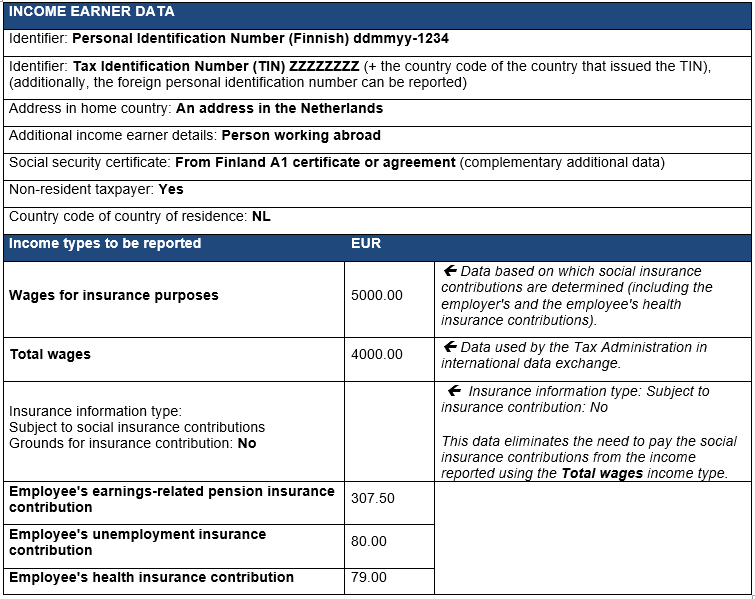
Reporting method 2
When reporting method 2 is used, the data must be submitted in two earnings payment reports. The wages for insurance purposes, used as the basis for the social insurance contributions, are reported in one report, and the actual paid wages for the purposes of the Tax Administration in another report.
Reporting the wages for insurance purposes: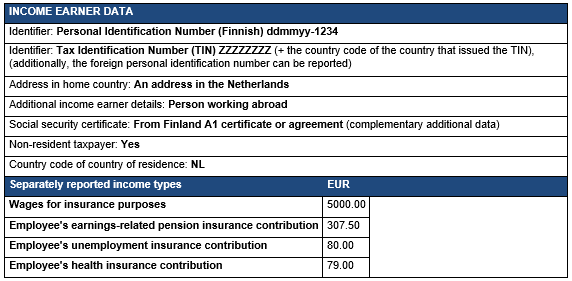
Reporting the actual wages paid: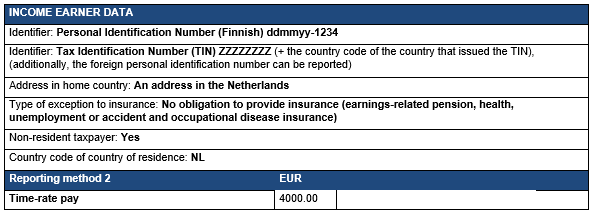
2.6.1.2 Income is taxed in Finland, tax at source
The wages paid to a non-resident taxpayer for work abroad may be taxable income in Finland. The wages are taxable when, for example, the payer is a public sector payer. The wages paid for work on board a Finnish ship or aircraft can also be taxed in Finland. Tax at source or withholding must be collected from the wages.
If the income is subject to tax at source, the payer may make a tax-at-source deduction of the income only if the tax at source card includes the relevant entry. The employee's health insurance contribution must be reported separately.
The social insurance contributions are paid based on the wages for insurance purposes. The employee's health insurance contribution is also paid based on the wages for insurance purposes. However, tax at source must be collected based on the actual wages paid.
When a public sector organisation pays income to a non-resident taxpayer, the additional payer details must indicate that the payer is a public sector organisation.
Example 11: A non-resident taxpayer works in the service of a public sector entity in France. He has an A1 certificate from Finland. EUR 3,000 has been agreed as the amount of the employee's wages for insurance purposes. The social insurance contributions (including the employer's and the employee's health insurance contributions) are paid based on the wages for insurance purposes.
The income earner is paid EUR 2,500 in wages. The employee presents a tax at source card to the employer; the card includes an entry of a tax at source deduction, EUR 510 per month. The 35% tax at source is paid according to the actual wages paid, 35% x (EUR 2,500 – 510) = EUR 696.50.
Reporting method 1
If the data is reported using reporting method 1, it can be submitted in a single earnings payment report as follows: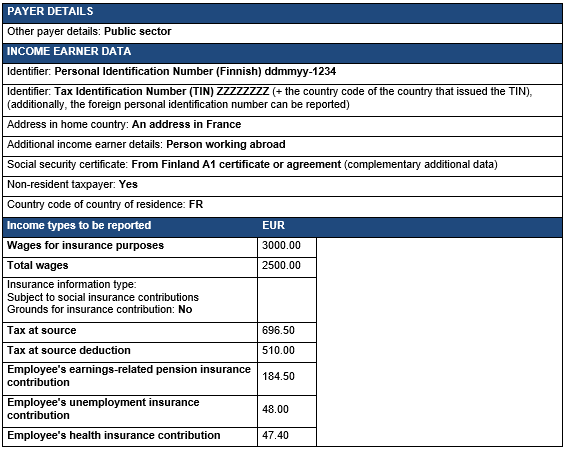
Reporting method 2
When reporting method 2 is used, the data must be submitted in two earnings payment reports. The wages for insurance purposes, used as the basis for the social insurance contributions, are reported in one report, and the actual paid wages for the purposes of the Tax Administration in another report.
Reporting the wages for insurance purposes: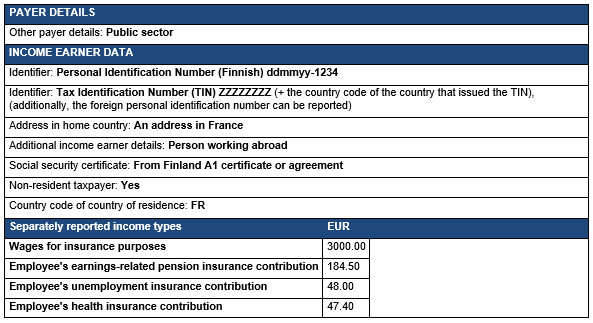
Reporting the actual wages paid: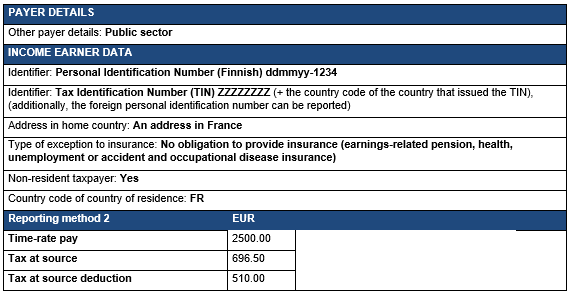
2.6.1.3 Income is taxed in Finland, taxation according to the Tax Procedure Act (so-called progressive taxation)
The payer may withhold tax from the wages paid to a non-resident taxpayer if the income earner presents a tax card of a non-resident taxpayer. The income earner details must then include an entry indicating that the income is subject to withholding. The employee's health insurance contribution is not reported separately; it is included in the withholding rate.
Example 12: A non-resident taxpayer works in the service of a public sector entity in France in Finland's representative office. He is a Finnish citizen and, according to the tax treaty, Finland has the right to tax his wages.
The employee has an A1 certificate from Finland. The amount of wages for insurance purposes has been agreed to be EUR 3,000. The social insurance contributions (with the exception of the employer's and the employee's health insurance contributions) are paid based on the wages for insurance purposes.
The amount of the wages paid is EUR 2,500. The employee has a tax card of a non-resident taxpayer with a tax rate of 20%. The tax is paid based on the actual wages paid, 20% x EUR 2,500 = EUR 500. The employee's health insurance contribution is included in the tax rate and is not reported separately. The employer's health insurance contribution is paid based on the actual wages paid.
If the data is reported using reporting method 1, it can be submitted in a single earnings payment report as follows:
Reporting method 1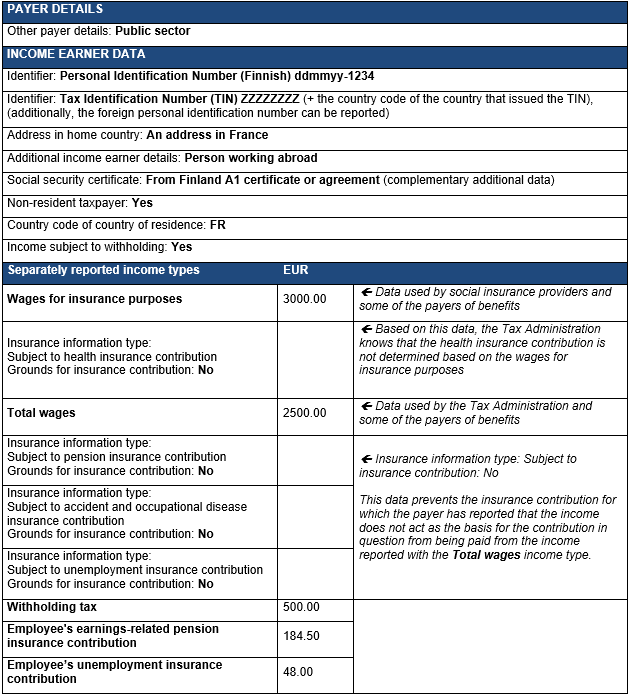
Reporting method 2
When reporting method 2 is used, the data must be submitted in two earnings payment reports. The wages for insurance purposes, used as the basis for the social insurance contributions, are reported in one report, and the actual paid wages for the Tax Administration and the determination of the health insurance contribution in another report.
Reporting the wages for insurance purposes: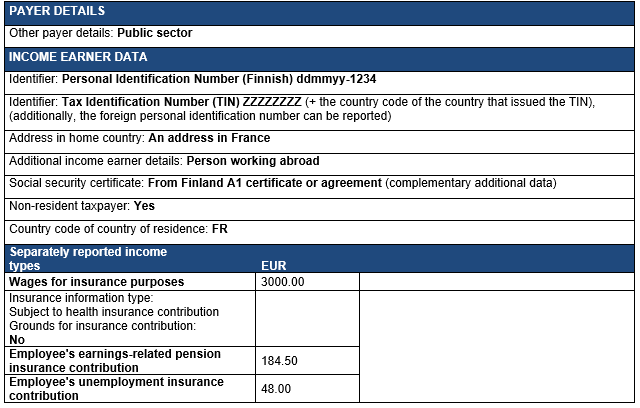
Reporting the actual wages paid: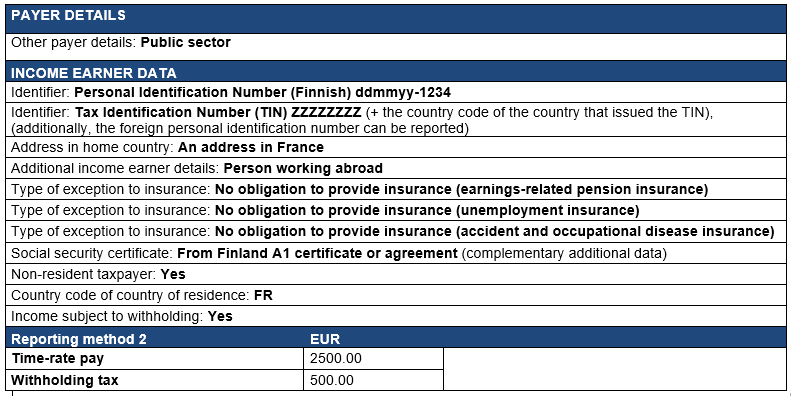
2.6.2 Income earner is not insured in Finland
If a non-resident taxpayer working abroad is not insured in Finland, the Finnish employer must report the actual wages paid to the Incomes Register.
Example 13: A Finnish private-sector employer hires a person living in the Netherlands to work in the Netherlands.
The amount of the wages is EUR 2,500. The employee is not covered by Finnish social security. According to Section 10 of the Income Tax Act, the wages are not taxed in Finland. Because the employee is not covered by Finnish social security, the social insurance contributions are not paid to Finland. The income must be reported to the Incomes Register, even if no taxes or social insurance contributions are collected from it.
The data to be reported to the Incomes Register: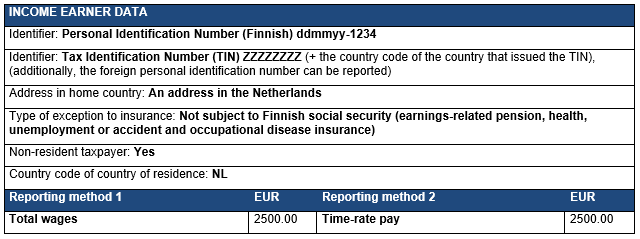
If the employee's wage income is taxable in Finland, the tax at source or withholding collected from the income is reported as follows:
Reporting income subject to tax at source:
Reporting income subject to withholding:
2.6.3 Income earner is voluntarily insured in Finland
A voluntary TyEL insurance (employee's earnings-related pension insurance) can be taken out for an employee who works abroad and is not subject to the mandatory TyEL insurance. In this situation, it is a requirement that the other statutory prerequisites concerning the employee and the employer are met. The wages for insurance purposes are also used as the basis for the pension in the voluntary TyEL insurance.
A voluntary TyEL insurance is reported to the Incomes Register by submitting the following data: Type of exception to insurance: Voluntary insurance in Finland (earnings-related pension insurance).
For more information on the voluntary TyEL insurance, see the pensions act service (www.tyoelakelakipalvelu.fi).
In corresponding situations, a Finnish employer can take out a voluntary insurance for accidents and occupational diseases for its employee working abroad. This is not reported to the Incomes Register; the employer handles the insurance coverage directly with an insurance company.
2.6.4 Foreign group company pays the wages
If a non-resident taxpayer working abroad is insured in Finland and works for a group company, the Finnish company that posted the employee must pay the employer's health insurance contribution and other social insurance contributions (including the employee's share of the earnings-related pension and unemployment insurance contributions) to Finland. The contributions are paid based on the wages for insurance purposes, and the data must be reported to the Incomes Register. The income is not taxable in Finland, and withholding or tax at source will not be collected to Finland.
When a foreign group company pays the wages to an employee posted abroad who is insured in Finland, the Finnish company that posted the employee must submit the Foreign group company data as other payer details and the Person working abroad as an additional income earner detail.
The Finnish company reports to the Incomes Register the wages for insurance purposes and the employee's shares of the earnings-related pension and unemployment insurance contributions. Based on the data submitted to the Incomes Register, the Tax Administration determines the amount of the employee's health insurance contribution in final taxation, and it is paid as back tax.
2.7 Correcting information in situations involving work abroad
2.7.1 Applicability of the six-month rule is not confirmed until later
If a work assignment abroad was initially planned to last only a couple of months, but the assignment continues for over six months, the payer may have to correct the information it has reported to the Incomes Register.
Example 14: A Finnish employer posts an employee to Switzerland for four months from the beginning of February. At the end of April, the employer and the employee agree that the posting will be extended by four months, i.e. the posting will last for a total of eight months.
If the requirements of the six-month rule are met and the wage income is tax-exempt in Finland, the employer may correct the information it has submitted to the Incomes Register and return the taxes withheld to the employee with the exception of the minimal withholding. Generally, wages for insurance purposes have to be retroactively determined for the employee. See Section 2.7.2 for a description of the retroactive determination of wages for insurance purposes.
The payer has reported the wages for February-April in the same way as if the income earner had worked in Finland. In May, the payer corrects the information reported to the Incomes Register. The payer uses a replacement report to indicate that the six-month rule is applicable. The amount of wages is EUR 4,000 and the tax rate according to the tax card is 25%, i.e. the amount of tax withheld is EUR 1,000.
In May, the employer also returns the difference between the tax withheld and the minimal withholding to the employee. A separate report must be submitted to the Incomes Register of the return, in which the returned amount is reported as a negative number. In 2017, the amount of the minimal withholding is 1.58%, or EUR 63.20. The amount returned is thus EUR 3,000 – 189.60 = 2,810.40.
In this example, the wages for insurance purposes are not retroactively determined.
The payer corrects the earnings payment reports for February-April as follows: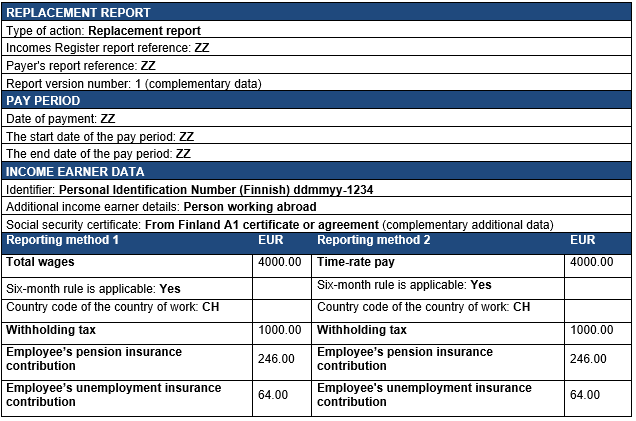
The returning of the tax withheld is reported as follows:
In situations involving working in a Nordic country, it must be taken into consideration, however, that the employer cannot return the tax withheld from the wages to the employee even if the six-month rule could be retroactively applied to the income. This is due to the Nordic Agreement Concerning the Collection and Transfer of Tax (the so-called TREKK Treaty), according to which an authority transfers taxes groundlessly collected in one Nordic country to another Nordic country (the country of work). The procedure is described in Section 2.5, Additional information on work in a Nordic country.
2.7.2 Wages for insurance purposes are retroactively determined
If the wages for insurance purposes are retroactively determined, the information must be corrected in the Incomes Register by submitting a replacement report.
Example 15: A Finnish employer posts an employee to Switzerland for four months from the beginning of February. The amount of wages is EUR 4,000 and the tax rate according to the tax card is 25%, i.e. the amount of tax withheld is EUR 1,000.
At the end of April, the employer and the employee agree that the posting will be extended by four months, i.e. the posting will last for a total of eight months.
Wages for insurance purposes are retroactively determined for the employee from the beginning of February. The amount of the wages for insurance purposes is agreed to be EUR 5,000. The employer's social insurance contributions and the employee's health insurance contribution are paid based on the wages for insurance purposes.
The payer has reported the wages for February-April in the same way as if the income earner had worked in Finland. In May, the payer corrects the information reported to the Incomes Register.
The employer returns the difference between the tax withheld and the minimal withholding to the employee. In 2017, the amount of the minimal withholding is 1.58%, or EUR 5,000 x 1.58% = EUR 79.
When the employee's earnings-related pension insurance or unemployment insurance contribution has not been collected during the payment of wages due to an apparent error, the employer may collect the uncollected contribution during the next two payments of wages, but not after that. For this reason, in this case the employer has to pay both the employee's share of the contributions and the employer contributions. The employee's share of the contributions is taxable income of the employee. However, because the six-month rule applies to wage income in income taxation, the employee's share of the contributions is tax-exempt in Finland under Section 77 of the Income Tax Act.
Because the amount of the employer's health insurance contribution changes, the employer must also correct the employer's separate report in which it has reported the total amount of employer's health insurance contributions to the Incomes Register. Employer's separate reports are corrected with the same procedure used in the correction of earnings payment reports.
The payer corrects the earnings payment reports for February-April as follows: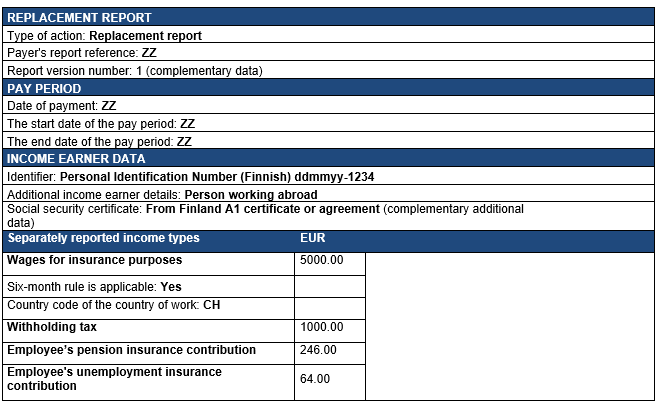
The payer also submits a new report, reporting the returning of the withheld tax, as follows:
For more information on correcting an employer's separate report, see Correcting information in the Incomes Register, Chapter 7, Correcting an employer's separate report.
3 Reporting the data of an income earner coming to Finland from abroad
Payments made to an income earner coming to Finland from abroad are reported to the Incomes Register using an earnings payment report. It does not matter whether the income earner is a resident or non-resident taxpayer. The data must be reported also in the case that the income is not taxed in Finland or the employee is not insured in Finland.
The data should primarily be reported using a Finnish Personal Identification Number. For more information on customer identifiers, see Section 1.7, Customer identifiers.
The Reporting obligations of foreign employers are described in Section 4.
3.1 Social insurance contributions and provision of insurance
An income earner coming to Finland from abroad is primarily covered by Finnish social security and the social insurance contributions are paid to Finland. The social insurance contributions are reported to the Incomes Register in the same way as for other income earners.
When the EU social security regulations are applied to an employee coming to Finland and the employee has an A1 certificate from his/her country of origin, he/she is insured in his/her country of origin with respect to all social insurances. There is then no need to pay the employer's or the employee's health insurance contributions or other social insurance contributions to Finland.
When the legislation of another country is applied to an employee based on a social security agreement and the employee has a certificate of the applicable social security, there is no need to pay to Finland those insurance contributions covered by the social security agreement. Different social security agreements apply to different
insurance contributions.
If an employee coming to Finland from abroad works in Finland for no more than four months, there is no need to pay the employer's or the employee's health insurance contributions to Finland, even if the employee does not have a certificate of being covered by the social security of his/her country of origin. However, the other social insurance contributions must usually be paid. There are certain exceptions to this; more information on these is available from the parties mentioned below.
If the work in Finland does not fulfil the so-called period of employment condition, the employer's or the employee's health insurance contributions do not need to be paid from the income. However, the other social insurance contributions must usually be paid. For more information on the period of employment condition, see the Kela website, for example.
For further information on the social insurance contributions in different situations, see the insurers' own websites:
- earnings-related pension insurance: the payer's earnings-related pension provider or the Finnish Centre for Pensions (www.etk.fi)
- unemployment insurance: Unemployment Insurance Fund (www.tvr.fi)
- accident and occupational disease insurance and employee's group life insurance: the payer's accident insurance company or the Workers' Compensation Center (www.tvk.fi)
- employer's health insurance contribution and employee's health insurance contribution: Tax Administration (www.vero.fi) and Kela (www.kela.fi).
3.2 Resident taxpayer works in Finland
The income of a resident taxpayer coming to Finland from abroad is reported to the Incomes Register in the same way as the income of someone living in Finland. If the social security of the employee's country of origin is applied to the employee, the insurance contributions covered by the social security agreement are not collected from him/her.
Example 16: A person living in Sweden comes to work in Finland for two years in the service of a Finnish employer. He has an A1 certificate from Sweden that shows that he is insured in Sweden. The employer does not need to pay any social insurance contributions to Finland, and no health insurance
contributions are levied from the employee in Finland.
The payer reports the insurance information to the Incomes Register as follows:
Example 17: A person living in South Korea comes to work in Finland for one year, posted by a South Korean employer. The payment of wages is transferred to the Finnish company. The employee has a certificate according to which the social security agreement between Finland and South Korea is applied to him. The agreement covers the earnings-related pension and unemployment insurance contributions. The other social insurance contributions are paid to Finland.
The payer reports the insurance information to the Incomes Register as follows:
3.3 Non-resident taxpayer works in Finland
The income paid to a non-resident taxpayer and other data are reported to the Incomes Register in the same way as income paid to a resident taxpayer. Furthermore, the following data must be included in the income earner details: Non-resident taxpayer: Yes. The data is reported using a Finnish Personal Identification Number when the income earner has a Finnish ID. Furthermore, the foreign Tax Identification Number, the country of residence and the contact information in the country of residence are always reported of an income earner who is a non-resident taxpayer. If an employee who is a non-resident taxpayer does not have a Finnish Personal Identification Number, the payer must report, in addition to the foreign identifier, the employee's name, date of birth, address and gender.
If the wage income paid to the non-resident taxpayer is subjected to withholding instead of tax at source, the following data must be included: Income subject to withholding: Yes (so-called progressive taxation of a non-resident taxpayer). The payer can withhold tax from the wage income paid to a non-resident taxpayer only if the employee has a tax card of a non-resident taxpayer.
When reporting the data of a non-resident taxpayer to the Incomes Register, the data submitter may submit, for example, the Social security certificate data and the employee's periods of stay and work in Finland as complementary additional data.
See below for examples of the data to be submitted in an earnings payment report, when payments are made to an income earner who is a non-resident taxpayer.
3.3.1 Income earner is not insured in Finland
3.3.1.1 Income is subject to tax at source
Example 18: A person living in Estonia comes to work in Finland for five months in the service of a Finnish employer. He has an A1 certificate from Estonia that shows that he is insured in Estonia. The employee has acquired a tax at source card from a tax office.
The employer pays EUR 2,500 in monthly wages. The employee's tax at source card includes an entry on the payer's right to make a tax at source deduction of EUR 510 per month from the income earner's income before collecting tax at source. The payer collects tax at source from the income: 35% x (2,500 – 510), or EUR 696.50. Social insurance contributions do not need to be paid to Finland, because the employee is not insured in Finland.
The payer reports the data to the Incomes Register: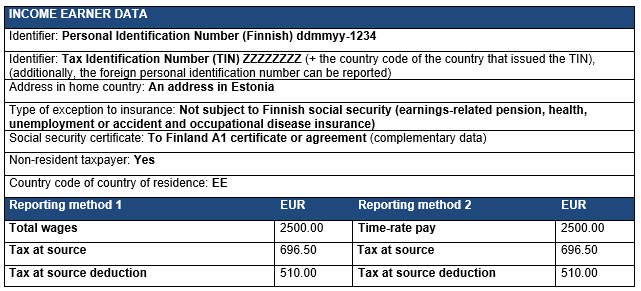
3.3.1.2 Income is subject to withholding (progressive taxation)
Example 19: As above, but instead of a tax at source card, the employee has a non-resident taxpayer's tax card. The payer must include the following data in the income earner's details: Income subject to withholding: Yes.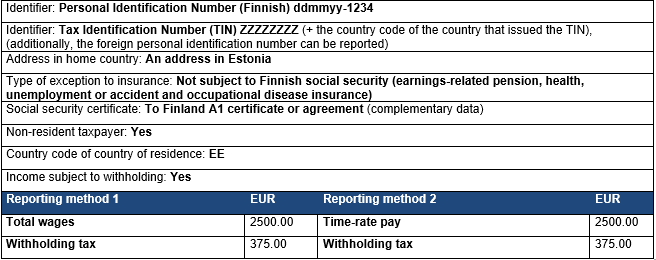
3.3.2 Income earner is insured in Finland
3.3.2.1 Income is subject to tax at source
Example 20: The situation is otherwise the same as in the previous examples, but the income earner does not have an A1 certificate from his/her country of origin.
A person living in Estonia comes to work in Finland for five months in the service of a Finnish employer. Because the employee does not have an A1 certificate from his/her country of origin, he/she is insured in Finland.
The employer pays EUR 2,500 in monthly wages. The income earner's tax card includes an entry on the payer's right to make a tax at source deduction of EUR 510 per month from the income before collecting tax at source. The payer collects tax at source from the income: 35% x (2,500 – 510), or EUR 696.50. The social insurance contributions are determined by the gross wages. The health insurance contribution of an income earner who is a non-resident taxpayer must be collected separately in addition to tax at source and reported to the Incomes Register.
The payer reports the data to the Incomes Register: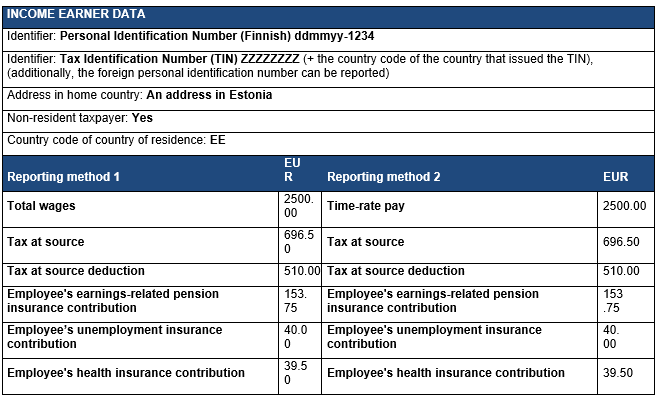
3.3.2.2 Income is subject to withholding (progressive taxation):
Example 21: The situation is otherwise the same as in the previous example, but the employee has a non-resident taxpayer's tax card. The payer must include the following data in the income earner's details: Income subject to withholding: Yes.
A person who is a non-resident taxpayer and lives in Estonia comes to work in Finland for five months in the service of a Finnish employer. He does not have an A1 certificate from his country of origin, i.e. he is insured in Finland. The employer pays EUR 2,500 in monthly wages and withholds tax from the wages in accordance with the withholding rate specified on the tax card (22%), or EUR 550.
The employee's health insurance contribution is included in the withholding rate, due to which the employee's health insurance contribution is not collected separately or reported to the Incomes Register. The other social insurance contributions are determined based on the gross wages.
The payer reports the data to the Incomes Register: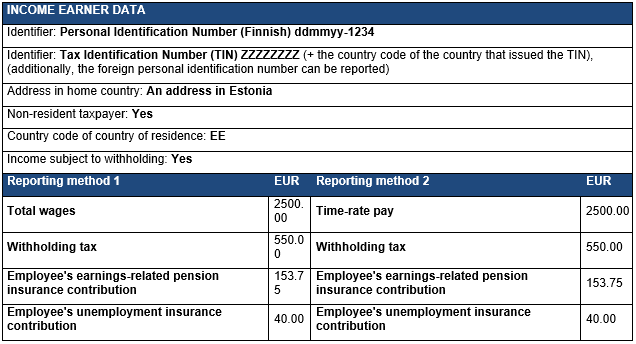
3.3.3 Income earner insured with respect to only some social insurances
Resident and non-resident tax liability are information affecting taxation. They have no effect on the obligation to provide insurance. The following situations related to insurance may apply to both resident and non-resident taxpayers.
3.3.3.1 Income earner is not health insured in Finland
If a person coming to Finland from abroad is not insured in Finland under the Health Insurance Act, the employer's or the employee's health insurance contributions do not need to be paid from the wages paid. However, the other insurance contributions must usually be paid. For more details on social insurance contributions, see Section 3.1, Social insurance contributions and provision of insurance.
Example 22: An employee comes to Finland from Germany to work in the employment of a Finnish employer for three months. He does not have an A1 certificate from Germany. He has obtained a tax card that takes the tax at source deduction, EUR 510 per month, into account. His wages are EUR 2,000 per month. The amount of tax at source is 35% x (EUR 2,000 – 510) = EUR 521.20.
Because the work in Finland lasts for under four months, the employee is not insured in Finland under the Health Insurance Act. The data is reported to the Incomes Register as follows: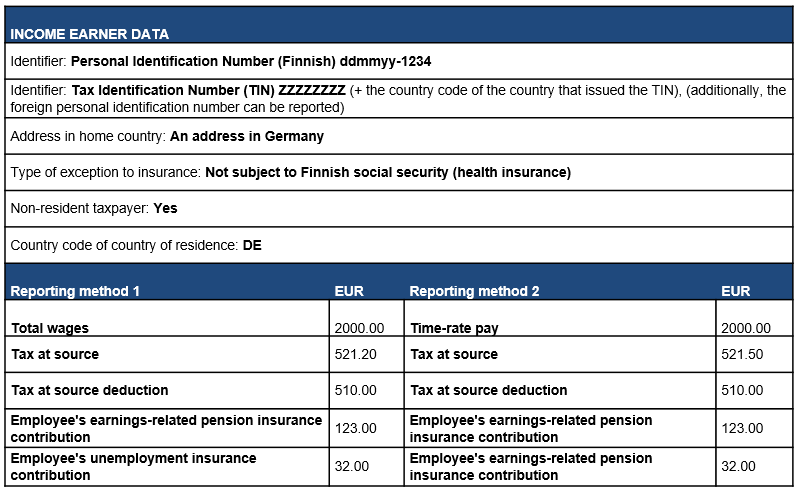
3.3.3.2 Income earner is not earnings-related pension or unemployment insured in Finland
The social security agreements made by Finland may only apply to some of the social insurance contributions. If the applicable social security agreement does not cover some insurance contributions, they must be paid to Finland in accordance with Finnish legislation. For more detail on the social security agreements, see the pensions act service (www.tyoelakelakipalvelu.fi).
Example 23: An employee has been posted from China to work in Finland for five months. The employee has a certificate from his country of origin, according to which the Chinese social security is applied to him. His wages are paid by the Finnish company. The social security agreement between Finland and China only covers the pension and unemployment insurance contributions. These contributions do not need to be paid to Finland, but the other social insurance contributions are paid in the normal manner. The employer's and the employee's health insurance contributions must also be paid based on the wages.
Income data as in the previous example. 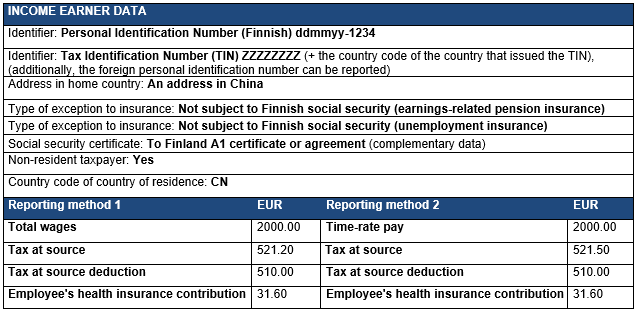
3.4 Au pairs and trainees
The pocket money paid to an au pair coming to Finland from abroad is taxable wage income. The au pair has a board and lodging benefit from living with the family. However, the au pair's pay does not usually fulfil the so-called period of employment condition, due to which the employer's or the employee's health insurance contributions do not need to be paid from it. However, the other social insurance contributions must be paid.
If, however, the au pair comes to Finland for more than two years, the employer's and the employee's health insurance contributions must be paid, unless the employee has a Kela certificate of not being health-insured in Finland or not covered by residence-based social security.
Each year, the Tax Administration will confirm the value of fringe benefits by a decision of the Tax Administration on the calculation methods of fringe benefits.
Example 24: An au pair comes to Helsinki on 30 April 2017 and stays in Finland for more than six months. The employee is a resident taxpayer in Finland. During 2017, she has time to work for eight months.
The au pair's take home pay, or the so-called net pay, is EUR 300 per month. She is also paid a bus ticket worth EUR 52.40 per month. Her pay also includes board and lodging in a single room, worth EUR 498 per month. The bus ticket and the board and lodging benefit are fringe benefits. Calculated using the gross wages calculator on the vero.fi website, her gross wages come to EUR 921.84 per month. The calculation of the gross wages take into consideration the taxes collected from the income and the employee's share of the earnings-related pension and unemployment insurance contributions. The withholding rate comes to 0%. No employer's or the employee's health insurance contribution is paid based on the wages, because the wages are less than EUR 1,187 per month, i.e. the period of employment condition is not fulfilled (the annually changing euro limit can be checked on Kela's website). The earnings-related pension and unemployment insurance contributions are paid based on the gross wages.
Tax is withheld from the au pair's gross wages according to the withholding rate on the tax card, and also the employee's share of the earnings-related pension and unemployment insurance contributions. The contributions are collected from the gross wages paid in cash (gross wages – fringe benefits). The au pair's take home pay is EUR 300.
Because in the example, the au pair's tax rate is 0%, there is no need to withhold tax or report it to the Incomes Register.
The data to be reported to the Incomes Register: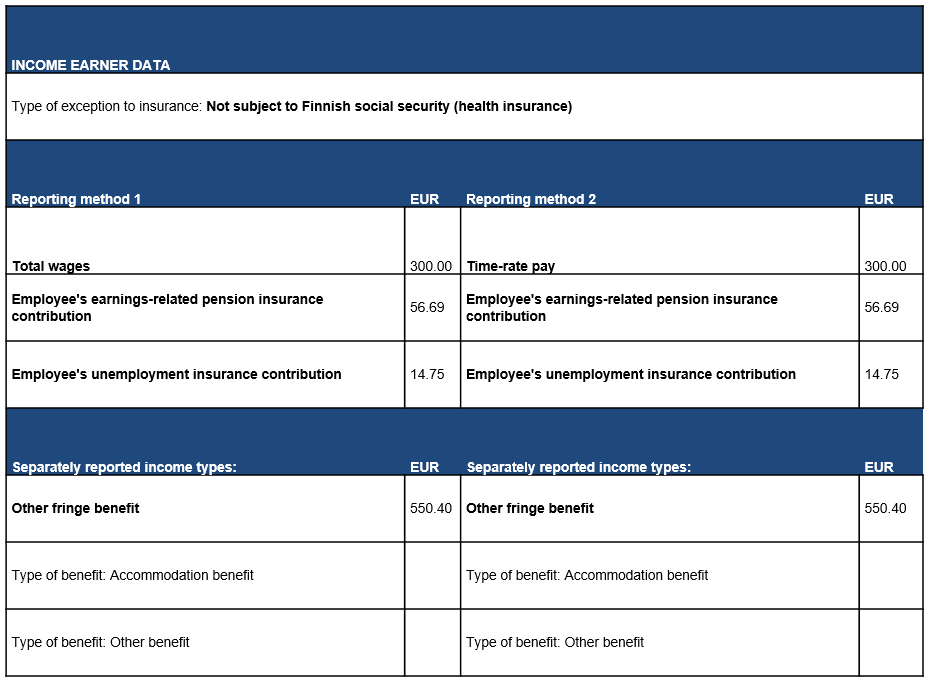
If the au pair does not stay in Finland for more than six months, she is a non-resident taxpayer in Finland. The au pair may visit a tax office and obtain a non-resident taxpayer's tax card, in which case the income is subject to withholding instead of tax at source. In this case, the income data is reported in the same way as in the previous example. Because the income earner is a non-resident taxpayer, the payer must also report the following data on the income earner:
3.5 Correction of information
3.5.1 A non-resident taxpayer becomes a resident taxpayer
If the income earner initially intended to stay in Finland for no more than six months, but the duration of his/her stay is longer, the income earner becomes a resident taxpayer in Finland from the time of his/her arrival to Finland. If the payer has reported that the income earner is a non-resident taxpayer in the earnings payment reports submitted to the Incomes Register, the information must be corrected in the Incomes Register by submitting replacement reports for the previous months.
3.5.1.1 Income has been taxed according to the tax at source act
If tax at source has been collected from the wage income of a non-resident taxpayer, and the income earner becomes a resident taxpayer in Finland, the tax at source must be corrected to withholding. The correction must be made so that the income is correctly taxed. Additionally, the payer has reported income earner details for a non-resident taxpayer to the Incomes Register which must be corrected by submitting a replacement report.
Example 25: A person who is a non-resident taxpayer has stayed and worked in Finland from January to the end of March in the service of a Finnish employer. The employer has paid EUR 2,500 per month in wages. The employee's tax card includes an entry of the tax at source deduction, EUR 510 per month. The employer has collected tax at source from the income: 35% x (2,500 – 510), or EUR 696.50. The employee has an A1 certificate that shows that he is insured in his country of origin and does not therefore need to be insured in Finland.
The payer has reported the data on the wages paid in January-March to the Incomes Register monthly as follows: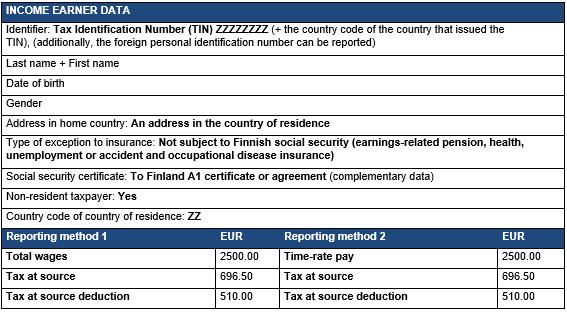
Additionally, the periods of work and stay in Finland can be reported as complementary data.
In March, the employer and the employee agree that the employment will be extended until the end of the year. Because the employee's stay in Finland lasts more than six months, he becomes a resident taxpayer from the beginning of his work.
The payer must correct the reports submitted for January-March by submitting replacement reports so that the income is correctly taxed. The collected taxes at source must be changed to withholding. The withholding is reported with the same amount as the tax at source collected from the employee. The tax at source deduction is not reported in the replacement report, because an employee who is a resident taxpayer is not entitled to it.
In order for it to be possible to continue to apply the social security of the employee's country of origin to the employee, the A1 certificate must remain valid until the end of the year. If the A1 certificate remains valid only until the end of March and it is not extended, the employer's and the employee's health insurance contributions and other social insurance contributions must be paid to Finland from the start of April.
At this time at the latest, the employee must apply for a Finnish Personal Identification Number. The payer must submit the employee's details to the Incomes Register by using both the Finnish Personal Identification Number and the foreign Tax Identification Number or personal identification number. Addresses abroad and in Finland can also be submitted as complementary data.
The replacement report does not need to include the data Non-resident taxpayer: Yes. In such a case, the data concerning a resident taxpayer can be submitted.
The payer must correct the data submitted for January-March as follows: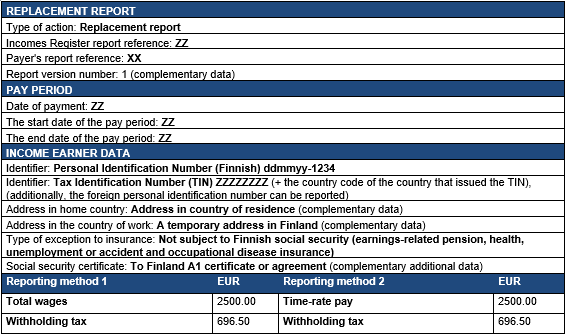
3.5.1.2 Income has been taxed according to the Tax Procedure Act (so-called progressive taxation of a non-resident taxpayer)
If an employee who is a non-resident taxpayer has visited a tax office and obtained a progressive tax card for wage income, the employer has withheld tax from the wages according to the withholding rate on the tax card. In addition to this, the employer has reported data concerning a non-resident taxpayer to the Incomes Register in the income earner details, which must be corrected.
Example 26: A person who is a non-resident taxpayer has stayed and worked in Finland from January to the end of March in the service of a Finnish employer. The employer has paid EUR 2,500 per month in wages. The employee has visited a tax office and obtained a tax card of a non-resident taxpayer with a tax rate of 5%. The employee has an A1 certificate that shows that he is insured in his home country and does not therefore need to be insured in Finland.
The payer has reported the data on the wages paid in January-March to the Incomes Register monthly as follows: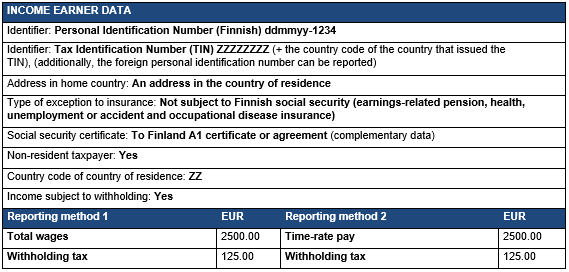
In March, the employer and the employee agree that the employment will be extended until the end of the year. Because the employee's stay in Finland lasts more than six months, he becomes a resident taxpayer from the beginning of his work. The employee visits a tax office and obtains a tax card of a resident taxpayer. The new tax card is valid from the beginning of April.
The payer must correct the reports submitted for January-March, because the employer has reported that the employee is a non-resident taxpayer in Finland in the earnings payment reports.
The payer must submit the employee's details to the Incomes Register by using both the Finnish Personal Identification Number and the foreign Tax Identification Number or personal identification number. Addresses abroad and in Finland can also be submitted as complementary data.
The replacement report does not need to include the data Non-resident taxpayer: Yes. In such a case, the data concerning a resident taxpayer can be submitted.
The payer must correct the data submitted for January-March as follows: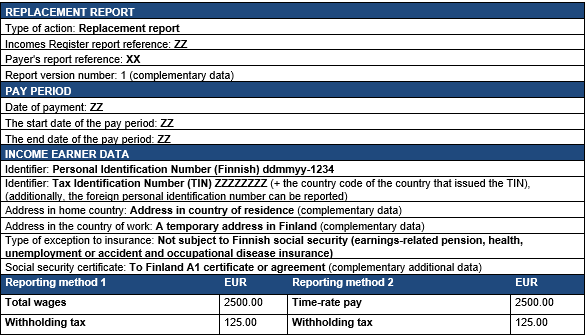
3.5.2 Taxation at source changes to progressive taxation
The wage income of a non-resident taxpayer is income subject to tax at source. The employer may collect tax at source from the income also without a tax at source card, but no tax at source deduction may be made from the income, then.
However, the non-resident taxpayer may request that the wage income is taxed progressively in accordance with the Tax Procedure Act. He/she must then present a tax card of a non-resident taxpayer to the employer. When progressive taxation is applied to wage income, the earned income for the entire year is taxed in the same way.
If tax at source has been collected from the wage income at first, and an earnings payment report has been submitted for it to the Incomes Register, and the income earner then presents a tax card of a non-resident taxpayer, the payer must correct the earnings payment reports submitted to the Incomes Register.
Example 27: A non-resident taxpayer comes to work in Finland from May to the end of September for five months in the service of a Finnish employer. The amount of the wages is EUR 2,000. The employee has visited a tax office and obtained a tax at source card with a withholding rate of 35%. Additionally, the tax-at-source card includes an entry on a tax at source deduction of EUR 510 per month.
During the payment of wages for May, the employer collects tax at source from the wages: 35% x (EUR 2,000 – 510) = EUR 521.50. Additionally, the employer collects the health insurance contribution and the employee's share of the earnings-related pension and unemployment insurance contributions from the wages.
The employee reports the data to the Incomes Register as follows: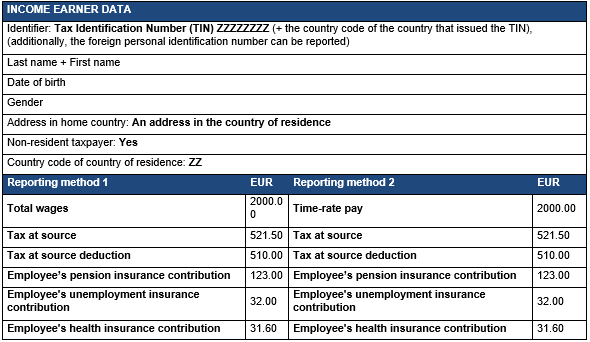
After the first payment of wages, the employee visits a tax office and applies for a Finnish Personal Identification Number and a progressive tax card. The tax card is valid from the beginning of June. The withholding rate on the tax card is 10%.
The payer must correct the earnings payment report submitted for May by submitting a replacement report. The collected tax at source must be changed to withholding. The withholding is reported in the same amount as the sum of the tax at source collected from the employee and the employee's health insurance contribution. The tax at source deduction is not reported in the replacement report, because the employee is not entitled to it when the income is taxed progressively.
The payer must submit the income earner's details to the Incomes Register by using both the Finnish Personal Identification Number and the foreign Tax Identification Number or personal identification number.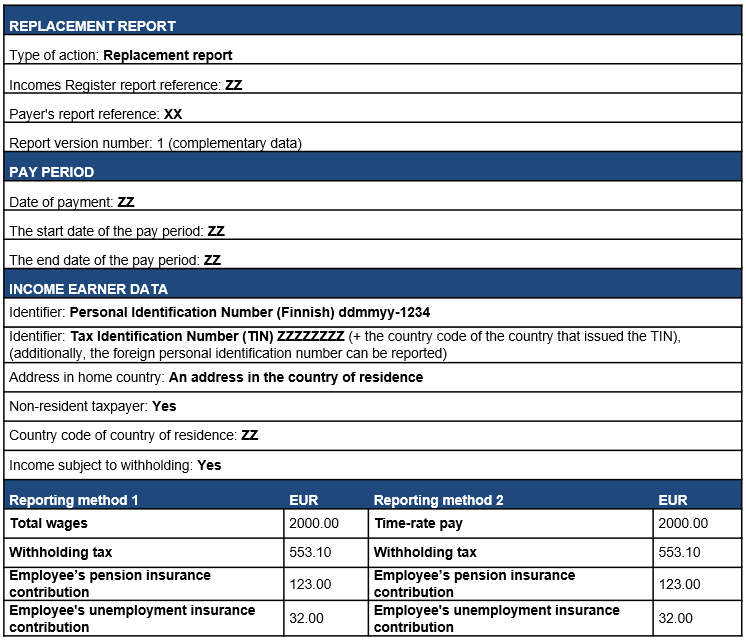
3.5.3 Changes and corrections to insurance information
3.5.3.1 Obligation to pay health insurance contributions retroactively
If a non-resident taxpayer works in Finland for less than four months, the employer's or the employee's health insurance contributions do not need to be paid from the income. If, however, the duration of the work is at least four months, the contributions must be paid retroactively.
If the employee remains a non-resident taxpayer and the income is subject to tax at source, the employer may collect the employee's health insurance contributions during the upcoming wage payments by increasing the tax at source rate. However, the tax at source may not be increased by more than ten per cent of the amount to be paid without the consent of the income earner.
For an employee who is a resident taxpayer and an employee who is a non-resident taxpayer but has chosen progressive taxation of his/her income instead of tax at source, the health insurance contribution is levied in final taxation.
If the information on health insurance changes, the payer must cancel the report previously submitted to the Incomes Register and submit a new report.
Example 28: A person who is a non-resident taxpayer and lives permanently in Germany has worked in Finland from January to the end of March in the service of a Finnish employer. The employer has paid EUR 2,500 per month in wages. The employee's tax card includes an entry of the tax at source deduction, EUR 510 per month. The employer has collected tax at source from the income: 35% x (2,500 – 510), or EUR 696.50.
The employee does not have an A1 certificate from his country of origin, i.e. he is covered by Finnish social security due to his work. However, because the duration of the work is less than four months, the employer's and the employee's health insurance contributions are not paid to Finland. The other social insurance contributions must be paid.
The payer has reported the data on the wages paid in January-March to the Incomes Register monthly as follows: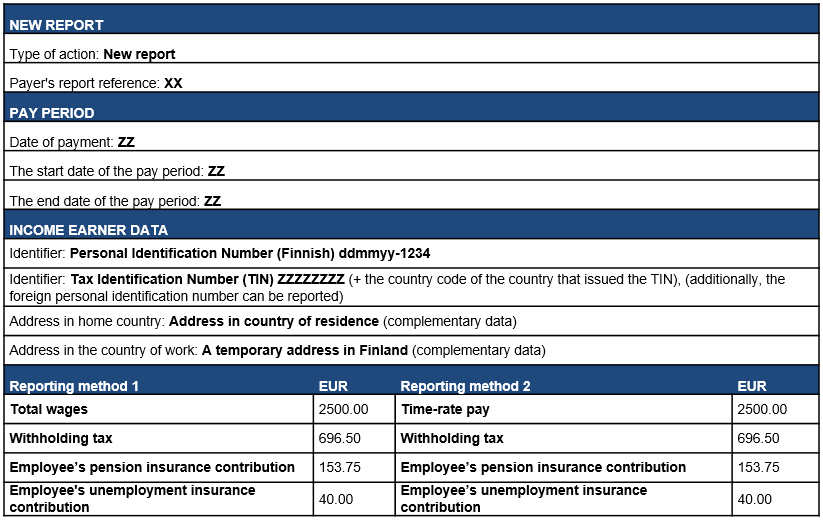
Additionally, the periods of work and stay in Finland can be reported as complementary data.
In March, the employer and the employee agree that the employment will be extended until the end of the year. Because the employee's stay in Finland lasts more than six months, he becomes a resident taxpayer from the beginning of his work. In such a case, the employee visits a tax office and obtains a new tax card. From the beginning of April, the employer withholds tax according to the tax rate on the tax card.
The payer must cancel the earnings payment reports submitted for January-March and submit new reports so that the income is correctly taxed.
Because the duration of the work is more than four months, the employer's and the employee's health insurance contributions must be paid to Finland. The payer must pay the employer's health insurance contributions retroactively. The employee's share is taken into account in the final taxation.
The collected taxes at source must be changed to withholding. The withholding is reported with the same amount as the tax at source collected from the employee. The tax at source deduction is not reported in the new report, because an employee who is a resident taxpayer is not entitled to it.
At this time at the latest, the employee must apply for a Finnish Personal Identification Number. The payer must submit the employee's details to the Incomes Register by using both the Finnish Personal Identification Number and the foreign Tax Identification Number or personal identification number. Addresses abroad and in Finland can also be submitted as complementary data.
The new report does not need to include the data Non-resident taxpayer: Yes. In such a case, the data concerning a resident taxpayer can be submitted.
Because the employee is health-insured from the beginning of his work in Finland, the employer must also correct the previously submitted employer's separate report with regard to the total amount of employer's health insurance contributions. The correction procedure is described in the instruction, Correcting information in the Incomes Register.
The earnings payment data must be cancelled as follows:
Additionally, new reports must be submitted as follows: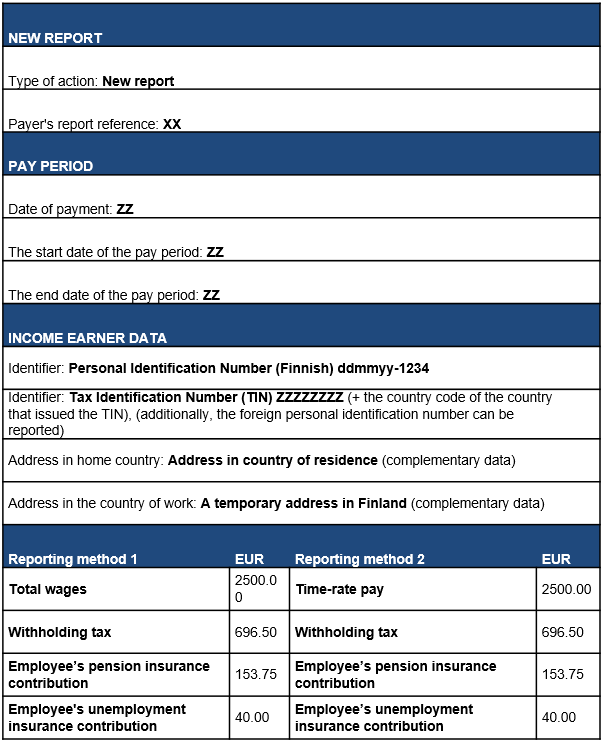
3.5.3.2 Information on obligation to provide insurance changes
3.5.3.2.1 Income earner has not been insured in Finland
Example 29: An employee coming to Finland from abroad intends to work in Finland for the entire calendar year, 1 January to 31 December. The employee has an A1 certificate to Finland. In such a case, no social insurance contributions need to be paid to Finland.
The payer has reported the following data to the Incomes Register: Type of exception to insurance: Not subject to Finnish social security (earnings-related pension, health, unemployment or accident and occupational disease insurance).
At the end of May, the employer finds out that the employee's A1 certificate had been revoked at the end of the previous year.
Employer contributions have not been paid and the employee shares have not been collected for five months.
If the employee's earnings-related pension insurance or unemployment insurance contribution has not been collected during the payment of wages due to an apparent error, the employer may collect the uncollected contribution during the next two payments of wages, but not after that. Because the contributions have not been collected for five months, the employer must in this case pay both the employee's share of the contributions and the employer contributions. The employee's share of the contributions is taxable income of the employee. For a description of reporting income to the Incomes Register, see the instruction, Reporting data to the Incomes Register: fringe benefits and reimbursement of expenses, Section 2.7.
The earnings payment reports submitted to the Incomes Register for January-May must be cancelled and new earnings payment reports submitted. For more details on correcting data by cancellation, see the instruction, Correcting information in the Incomes Register, Chapter 6.
Beginning from June, the employer reports the earnings payment data to the Incomes Register in the normal manner with a new earnings payment report.
3.5.3.2.2 The income earner has been insured in Finland
Example 30: An employee coming to Finland from abroad intends to work in Finland for the entire calendar year, 1 January to 31 December. The employee does not have an A1 certificate to Finland. The employer has paid social insurance contributions to Finland and reported all the necessary data to the Incomes Register.
At the end of May, the employee gives the employer an A1 certificate he received from his country of origin; the certificate has been valid from the beginning of the year. The employer has thus groundlessly paid social insurance contributions to Finland for five months.
The employer must cancel the reports submitted to the Incomes Register for January-May and submit new earnings payment reports. The following data is reported in the new earnings payment report:
- Type of exception to insurance: Not subject to Finnish social security (earnings-related pension, health, unemployment or accident and occupational disease insurance)
- Social security certificate: To Finland A1 certificate or agreement.
The insurance contributions incorrectly paid in January-May are returned to the employer, and the employer must return the incorrectly collected employee contributions to the employee. The employer must submit a report to the Incomes Register of the insurance contributions returned to the employee. The procedure is described in the instruction, Correcting information in the Incomes Register, Section 2.4, Reporting negative numbers.
4 Reporting obligation of a foreign employer
In these instructions, a company that has not been established in accordance with Finnish law or that has a registered domicile elsewhere than in Finland shall be considered a foreign employer. A person who acts as an employer and does not live in Finland is also deemed to be a foreign employer (non-resident taxpayer).
A foreign payer must report the data to the Incomes Register primarily using a Finnish Business ID or Personal Identification Number. For more information on customer identifiers, see Section 1.7, Customer identifiers.
In Other payer details, Foreign employer must be selected as the payer type when the foreign company does not have a permanent establishment in Finland. Additionally, in certain situations a foreign employer with no permanent establishment has to submit additional income earner details in addition to the income data. These are described in more detail in the examples of Section 4.3.
4.1 Social insurance contributions and provision of insurance
A foreign employer must pay the social insurance contributions to Finland when the employee is insured in Finland. If the employee has a certificate from his/her country of origin according to which he/she is covered by the social security of his/her country of origin, the social insurance contributions are not paid to Finland.
A foreign employer is obligated to pay the employer's health insurance contribution based on the wages only if it obtains a permanent establishment for income taxation in Finland. If the employer does not have a permanent establishment, the employer's health insurance contribution does not need to be paid even if the employee is insured in Finland.
Social insurance contributions or other fees collected from the employee in his/her foreign country of residence are not reported to the Incomes Register.
4.2 Permanent establishment for income taxation and employer registration
The formation of a permanent establishment for income taxation affects whether the foreign company must register with the Tax Administration's Employer Register and what additional income earner details must be reported to the Incomes Register when reporting the income.
If a foreign employer has a permanent establishment for income taxation in Finland, it is considered comparable to an employer in Finland with regard to employer obligations, and it must submit data to the Incomes Register in the same manner as a Finnish company. In such a case, Foreign employer is not reported as other payer details.
A foreign company must register with the Tax Administration's Employer Register as a regular employer if it has a permanent establishment for income taxation in Finland and pays wages for work performed in Finland. However, in certain cases, the company can be considered to be an employer casually paying wages. For more information on employer registration, see the Tax Administration Guidelines, Obligations of a foreign employer.
If a foreign employer does not have a permanent establishment for income taxation, it may register with the Employer Register if it so desires. In that case, the company will have the same employer obligations in taxation as Finnish companies. However, the employer must submit additional income earner details to the Incomes Register in addition to the income data (for more detail, see Sections 4.3.3., 4.3.4 and 4.3.5), and report as other payer details that the payer is a foreign employer.
A foreign employer that has no permanent establishment in Finland or has not registered with the Employer Register must report the data on payments it has made to the Incomes Register in the following situations:
- The income earner is insured in Finland.
- The income earner stays in Finland for more than six months.
- The income earner works as a leased employee for a service recipient in Finland. The data must be submitted when the tax treaty between the employee's country of residence and Finland allows the taxation of a leased employee's wages in Finland, or when there is no tax treaty. The employer must also report to the Incomes Register information needed by the Tax Administration, such as the leased employee's periods of work in Finland.
4.3 Reporting data to the Incomes Register when the employer is foreign
4.3.1 Wages paid to income earner working abroad when the income earner is insured in Finland
A foreign employer must report to the Incomes Register the income paid to an income earner in certain situations also when the work has been performed abroad. A foreign employer has a reporting obligation when the income earner must be insured in Finland. The obligation to provide insurance may apply when, for example, the income earner regularly works in several different EU/EEA countries or in Switzerland. The income earner will then have an A1 certificate from Finland, issued by the Finnish Centre for Pensions.
When an income earner working abroad is insured in Finland, the additional income earner details must include the Person working abroad data. In Other payer details, Foreign employer must be selected as the payer type when the foreign company does not have a permanent establishment in Finland.
The income earner can be a resident or non-resident taxpayer in Finland. In these kinds of situations, the data affecting taxation is reported in the same way as in Sections 2.3 A resident taxpayer works abroad and 2.6 A non-resident taxpayer works abroad.
4.3.2 Wages paid to a resident taxpayer for work performed in Finland
A foreign employer must report to the Incomes Register the wage income it pays to an income earner who stays in Finland for more than six months (resident taxpayer in Finland).
The obligation to report data to the Incomes Register for the Tax Administration only applies to work performed in Finland. However, a resident taxpayer has tax liability to Finland for global income. If the employee works partially in Finland and partially abroad during the same pay period, the foreign employer must submit data on the full income, i.e. also the share of the work performed abroad. If the employee is insured in Finland, a report must be submitted to the Incomes Register also when the work has been performed abroad in its entirety.
If the employer has no permanent establishment in Finland and has not registered with the Employer Register, the employer is not obligated to collect withholding from the employee's wages. The employee must then personally take care of the payment of taxes to Finland.
If the employer has a permanent establishment in Finland or has registered with the Employer Register, it must withhold tax from the employee's wages.
The employer must insure the employee in Finland if the employee is covered by Finnish social security.
Example 31: A person who lives permanently in Finland works in the service of a foreign company. The employer has no permanent establishment in Finland and has not registered with the Employer Register. The employee's wages are paid from abroad. The employee works solely in Finland. He is covered by Finnish social security.
The income paid to the employee is taxable in Finland. Because he is covered by Finnish social security, the foreign employer is obligated to provide insurance to the employee in Finland and pay the social insurance contributions to Finland. However, the employer does not need to pay the employer's health insurance contribution to Finland, because it does not have a permanent establishment for income taxation in Finland.
The following data must be reported to the Incomes Register: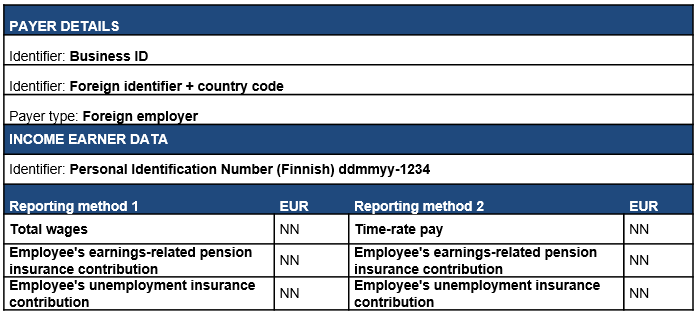
4.3.3 Employee leasing
A foreign employer must report to the Incomes Register any payments it makes to a leased employee coming to work in Finland from abroad.
The data must be submitted when the tax treaty between the employee's country of residence and Finland does not prevent Finland from taxing the employee's wage income. This data must also be submitted when there is no tax treaty.
Additionally, the employer must submit the data of the foreign employee leasing notice. The data is submitted for the Tax Administration. The data can be submitted either in connection with earnings payment data or separately. The recommendation is, however, that the data on the employee leasing notice is submitted in a separate earnings payment report.
If the employer is registered in the Prepayment Register, the employer is obligated to report the data to the Incomes Register. If the employer is not registered in the Prepayment Register, a representative of the foreign employer has a secondary obligation to report the data required for taxation to the Incomes Register. If, however, the representative does not report the data, it must be reported by the foreign employer. For more information on the reporting obligation of a representative, see Section 1.3, Representative of a foreign employer.
When a representative reports data to the Incomes Register on behalf of the employer, the representative's details must include Representative acts as submitter. The representative enters his/her/its own details in the Representative data group. In both an employee leasing notice and an earnings payment report, the representative specifies the actual employer as the payer. The representative can submit the data electronically if authorised to act on behalf of the actual employer. If the representative is not authorised, the data must be submitted on a paper form. In this case, too, the employer is specified as the payer.
4.3.3.1 Employee leasing notice
The employee leasing notice for a foreign leased employee must be submitted for every leased employee regardless of the duration of their work. The data must be submitted when the tax treaty between the employee's country of residence and Finland does not prevent Finland from taxing the employee's wage income or when there is no tax treaty. When the employee begins working in Finland, the employee leasing notice must be submitted no later than on the fifth calendar day following the first wage payment date. The data must include the estimated duration of the work assignment, the details of the Finnish service recipient and the details of the representative of the foreign employer. Furthermore, an estimate of the amount of pay for the entire tax year must be reported.
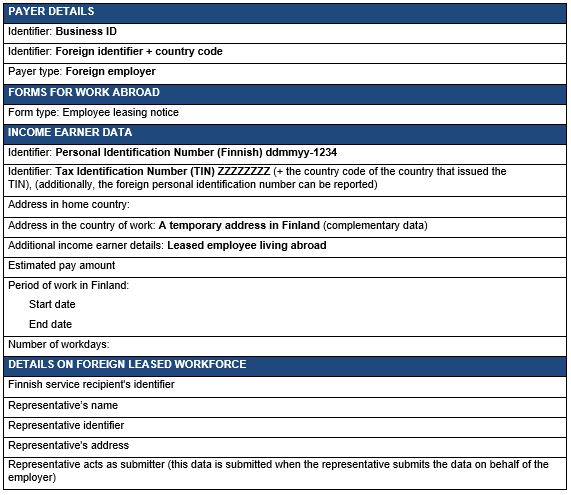
4.3.3.2 Wages of a leased employee paid by a foreign employer
When wages paid to a leased employee living abroad is reported to the Incomes Register, the following data must be included as an additional income earner detail: Leased employee living abroad. The data must be specified regardless of the duration of the work or whether the employee is a resident or non-resident taxpayer in Finland.
The additional detail Leased employee living abroad is submitted only when the foreign employer has no permanent establishment for income taxation in Finland. If the employer has a permanent establishment in Finland, this additional income earner detail is not used. In such a case, the payer does not need to report the other payer detail Foreign employer.
A report needs to be submitted to the Incomes Register only for leased employees coming from the following countries or regions: Iceland, Norway, Sweden, Denmark, Latvia, Lithuania, Estonia, Georgia, Moldova, Belarus, Isle of Man, Poland, Turkey, Kazakhstan, Bermuda, Jersey, Guernsey, Cayman Islands and Cyprus. Tajikistan, Germany and Turkmenistan.
A report must also be submitted for leased employees who reside in Bulgaria, but work in Finland for non-Bulgarian employers.
A report must also be submitted for leased employees coming from countries with which Finland does not have a tax treaty. The treaties are listed on the web page Tax treaties.
If the employee is not covered by Finnish social security, this must be reported to the Incomes Register using the Type of exception to insurance data. The number of workdays must be reported when the income is paid to a non-resident taxpayer.
Read more on the taxation of foreign leased employees in Finland in the Tax Administration Guidelines, Foreign leased employees and taxation in Finland.
Example 32: An employee living in Estonia comes to work in Finland for five months. His foreign employer has leased him to work for a service recipient in Finland. The foreign employer has no permanent establishment in Finland and has not registered with the Employer Register. The employee has an A1 certificate from his country of origin, based on which he is covered by Estonian social security.
The employer pays the employee EUR 2,000 in monthly wages for the duration of his work in Finland. During the pay period, the employee has worked in Finland for 15 days. Because the employer has no permanent establishment in Finland and has not registered with the Employer Register, the employer is not obligated to collect withholding from the employee's wages. The employee is obligated to submit an application for tax prepayments and personally pay the taxes to Finland. Prepayments of tax are not reported to the Incomes Register.
Because the employee does not stay in Finland for more than six months, he is a non-resident taxpayer in Finland.
The data is reported to the Incomes Register as follows: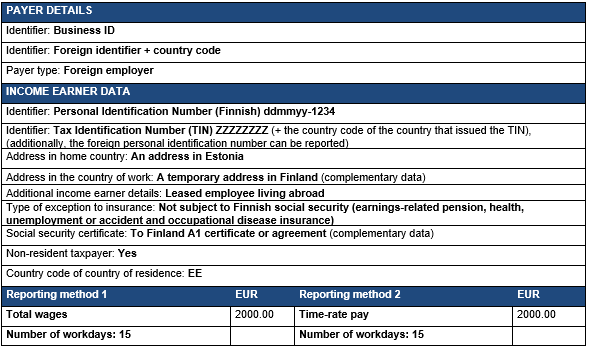
Additionally, the income earner's periods of stay in Finland can be reported as complementary data.
Example 33: An employee living in Poland comes to work in Finland for eight months. His foreign employer has leased him to work for a service recipient in Finland. The employer has no permanent establishment in Finland and has not registered with the Employer Register. The employee has an A1 certificate from his country of origin, based on which he is covered by Polish social security.
The employer pays the employee EUR 2,000 in monthly wages for the duration of his work in Finland. Because the employer has no permanent establishment in Finland and has not registered with the Employer Register, the employer is not obligated to collect withholding from the employee's wages. The employee is obligated to submit an application for tax prepayments and personally pay the taxes to Finland. Prepayments of tax are not reported to the Incomes Register.
Because the employee stays in Finland for more than six months, he is a resident taxpayer in Finland.
The data is reported to the Incomes Register as follows: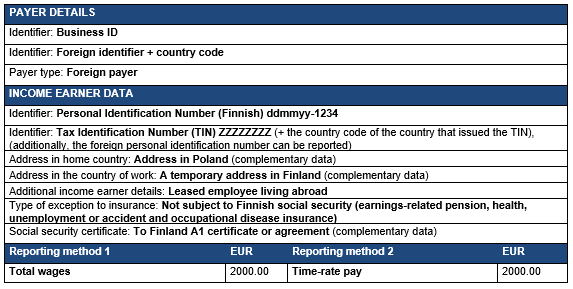
Additionally, the income earner's periods of stay in Finland can be reported as complementary data.
4.3.4 Wages paid by foreign employer when the employer pays taxes on behalf of the employee (employment contract ”Net-of-tax”)
A net-of-tax employment contract is a contract based on which the employer promises to pay the taxes and employee's social insurance contributions from the wages, on behalf of the employee. When the foreign employer has no permanent establishment in Finland, it must report Employer pays taxes on behalf of the employee ("Net-of-tax" employment contract) as an additional income earner detail in addition to the wages paid based on a net-of-tax employment contract. Furthermore, Foreign employer must be specified in other payer details. If the employer has a permanent establishment in Finland, the additional income earner detail or other payer details are not submitted.
The gross wages must be reported to the Incomes Register. The social insurance contributions are also determined based on the gross wages. The gross wages calculator on the Tax Administration's website can be used to help calculate the gross wages.
For more details on the net-of-tax employment contract, see the Tax Administration Guidelines, Employment contracts that define the employee's pay in 'net' terms.
4.3.5 Income earner did not stay longer than 183 days in Finland during the Tax-Treaty-defined sojourn period
A foreign employer must report to the Incomes Register data on wages it has paid when the income earner stays in Finland for more than six months (is a resident taxpayer in Finland). The income must also be reported to the Incomes Register when a tax treaty prevents Finland from taxing the income. A tax treaty prevents Finland from taxing the income if the employee stays in Finland no more than 183 days over a period of 12 consecutive months or during a calendar year, depending on the stipulations of the tax treaty between the employee's country of residence and Finland.
The additional data Income earner did not stay longer than 183 days in Finland during the Tax-Treaty-defined sojourn period is submitted when the foreign employer has no permanent establishment in Finland. If the employer has a permanent establishment in Finland, the wages are taxed in Finland and reported in the normal manner without additional income earner details.
When reporting the income, the country code of the country that has the right to tax the income must be reported.
If the income earner is insured in Finland, social insurance contributions must be paid from the wages to Finland.
If the stay in Finland happens to last longer so that the total stay exceeds 183 days over a period of 12 consecutive months or during a calendar year, depending on the tax treaty, the payer must correct the data submitted to the Incomes Register by submitting a replacement report. In the replacement report, the income is reported without the additional income earner detail Income earner did not stay longer than 183 days in Finland during the Tax-Treaty-defined sojourn period.
Example 34: An employee has come to work in Finland from Poland on 1 November 2019 and returns to his home country on 31 May 2020. His employer is a Polish company with no permanent establishment in Finland. His wages are EUR 2,500 per month. The employee has an A1 certificate from Poland, based on which he is covered by Polish social security.
The employee stays in Finland 20 days per month, or a total of 140 days during his posting. The employee is a resident taxpayer in Finland.
According to the tax treaty between Poland and Finland, Finland receives the right to tax wage income paid by a foreign company if the employee stays in Finland for more than 183 days over a period of 12 consecutive months. Because the stay period in Finland does not exceed the time limit of the tax treaty, Finland will not receive the right to tax the wage income. However, the payer must submit to the Incomes Register a report of the wages paid to the employee.
The data is reported to the Incomes Register as follows: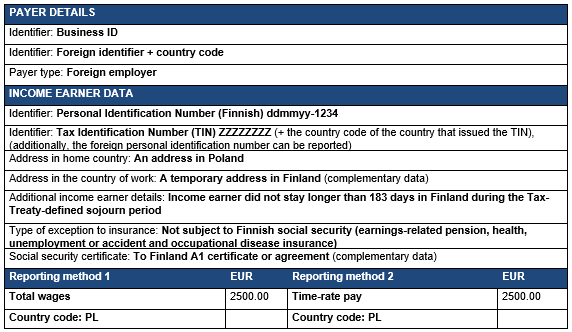
5 Special situations
5.1 Wages paid under the act governing the taxation of key employees
When the Act on the Tax at Source Payable by Foreign Wage-Earners (so-called key employee act) can be applied to wage income, the Key employee data must be specified in the additional income earner details. For more information on the applicability conditions of the key employee act, see the Tax Administration Guidelines, Taxation of employees from other countries.
The same additional income earner detail can also be used to report wages paid under the Act on the Nordic Investment Bank (NIB).
The special tax at source collected from wages is reported as collected tax at source. The tax at source also covers the employee's health insurance contribution, so the health insurance contribution is not collected separately. If, however, the employee is covered by Finnish social security, the other social insurance contributions must be paid.
The Key employee additional income earner detail is used only when the employee has obtained a tax card from the tax office, and an entry on the applicability of the key employee act has been made on the tax card. Data on the entire wages must be reported to the Incomes Register also in the situation where the employee can be considered to live in another country according to the tax treaty, based on which part of the wages is not taxed in Finland.
The key employee act cannot be applied for more than 48 months. If the application of the key employee act ends in the middle of the year and the person continues to work in Finland after this, the Key employee additional income earner detail is no longer used when reporting the wages for the rest of the year.
Example 35: A U.S. citizen living in the United States comes to work in Finland as a specialist for a Finnish employer for a period of four years. She applies for a tax card and presents an account on the applicability of the key employee act. The tax office makes an entry on the tax card, indicating that the key employee act can be applied to her income.
The employer pays the employee EUR 7,000 in monetary wages per month. The income earner does not have a certificate of the application of the social security legislation of her country of origin, i.e. she is covered by Finnish social security.
The employee's health insurance contributions are not separately collected from the wages. However, the other social insurance contributions must be paid.
The key employee is a resident taxpayer in Finland. The special tax at source for a key employee collected from the income is reported to the Incomes Register as tax at source.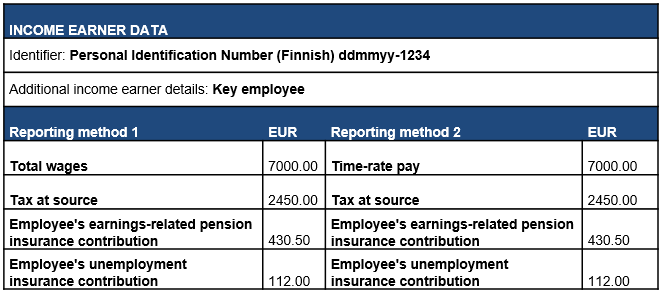
5.2 Wages paid for frontier work
Person working in a frontier district is reported as an additional income earner detail when the work is frontier work referred to in the Nordic Tax Agreement.
Work is frontier work when the income earner is a permanent resident of a Swedish or Norwegian municipality bordering Finland's land border and works in Finland in a municipality sharing the same land border. The provision on the taxation of frontier work in the Nordic Tax Agreement only applies to wage income.
No income tax is collected for the income in Finland, but the Finnish employer must pay the social insurance contributions and collect the employee's health insurance contribution based on the wages paid.
If the employee has an A1 certificate from his/her country of origin, the social insurance contributions are paid to the country that issued the certificate. If the person does not have an A1 certificate, but they work in Finland for no more than four months, no employer's or employee's health insurance contribution is paid to Finland. However, the other social insurance contributions must be paid.
If the employee performs part of their work in a non-frontier district in Finland, the share of the wages based on this work is subject to taxation in Finland. A separate report of this income must be submitted to the Incomes Register where the additional income earner detail related to frontier work is not included.
The frontier districts are:
- Municipalities sharing the same land border between Finland and Sweden are
- In Finland: Enontekiö, Kolari, Muonio, Pello, Tornio and Ylitornio, and
- In Sweden: Haparanda, Kiruna, Pajala and Över-torneå.
- Municipalities sharing the same land border between Finland and Norway are
- In Finland: Enontekiö, Inari and Utsjoki, and
- In Norway: Karasjok, Kautokeino, Kåfjord, Nesseby, Nordreisa, Storfjord, Sör-Varanger and Tana.
For more information on frontier work, see the Tax Administration Guidelines, Taxation of a frontier worker.
Example 36: A person living in Haparanda works in Tornio. She goes to work in Finland daily from her home. Her wages are EUR 3,000 per month.
The employee is a non-resident taxpayer in Finland. According to the Nordic Tax Agreement, her wages are taxed in her country of residence, Sweden. However, based on her work she is covered by Finnish social security. The employee has visited a tax office and obtained a tax card, according to which the wages paid for her work in a frontier district are not taxed in Finland.
The payer reports the data to the Incomes Register as follows: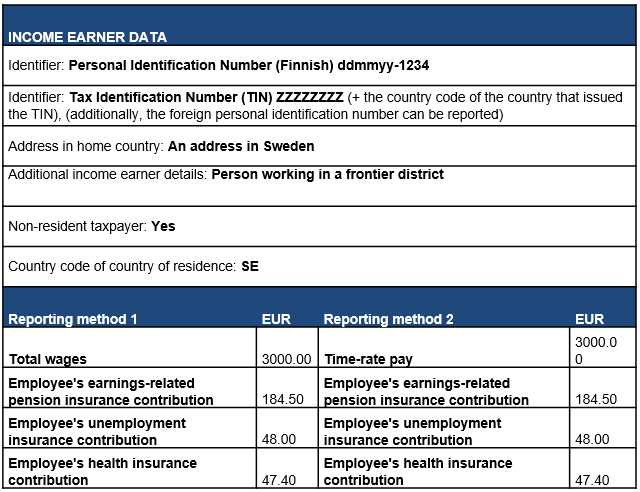
5.3 Athletes
An athlete can be paid wages or fees. Athlete's wages and athlete's fees are reported to the Incomes Register by specifying the Athlete data in the additional income earner details and using the income types for wages or non-wage compensation for work.
For more information on the payments made to an athlete and the social insurance contributions to be paid from them, see the instruction, Reporting data to the Incomes Register: rewarding employees, payments made to an entrepreneur and other special situations.
Example 37: An athlete living in Italy comes to Finland to play a sport for five months. He is a non-resident taxpayer in Finland. He has an A1 certificate, based on which he is covered by the social security of his country of origin. The amount of wages paid to him is EUR 3,000 per month, of which a tax at source of 15%, or EUR 450, is collected.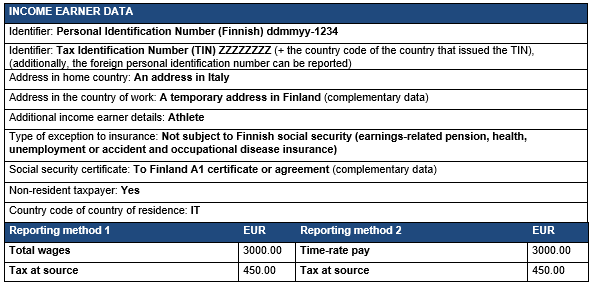
Additionally, the income earner's periods of stay in Finland can be reported as complementary data.
Example 38: An athlete living in Italy comes to Finland to play a sport for five months. He is a non-resident taxpayer in Finland. He does not have an A1 certificate from his country of origin, i.e. he is covered by Finnish social security. The amount of wages paid to him is EUR 3,000 per month, of which a tax at source of 15%, or EUR 450, is collected. Additionally, the employee's health insurance contribution and the employee's share of the earnings-related pension contributions must be collected from the income if a pension insurance must be taken out for the athlete by law.
The athlete's wages are subject to the employer's and the employee's health insurance contributions. If the athlete's earnings-related pension insurance contribution is collected from the athlete, it is reported to the Incomes Register under Employee's earnings-related pension insurance contribution so that the data is available for taxation.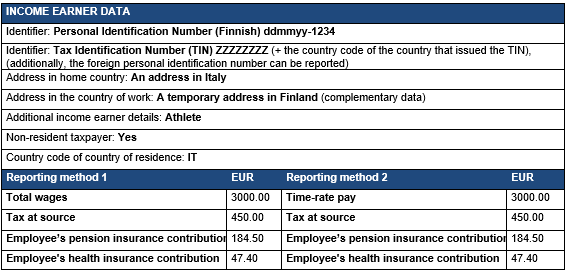
Additionally, the income earner's periods of stay in Finland can be reported as complementary data.
5.4 Performing artists
The compensation paid to a performing artist can be non-wage compensation for work or wage income. Performing artists include stage and film actors, radio and television performers, and musicians. When a performing artist is paid wages or a non-wage compensation for work he/she has done as a performing artist, the Performing artist data must be reported in the additional income earner details.
Example 39: A dancer living in France comes to work in Finland for three months in a theatre production. He is a non-resident taxpayer in Finland. He has an A1 certificate from France, based on which he is covered by the French social security.
The dancer has visited a tax office and obtained a tax at source card, according to which a tax at source of 15% must be collected from the income. He is paid EUR 2,000 in wages, of which the amount of tax at source is EUR 300.
The data is reported to the Incomes Register as follows: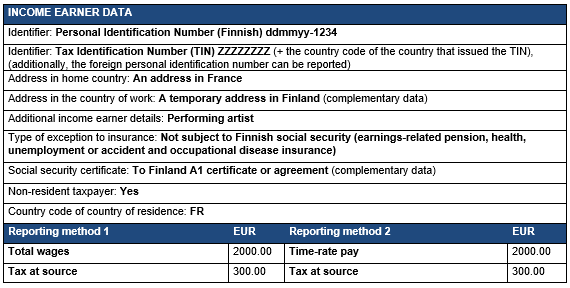
Additionally, the income earner's periods of stay in Finland can be reported as complementary data.
5.5 Wages paid by a specialised agency
When the payer is a specialised agency established with an international agreement, Specialised agency must be specified in other payer details. Such specialised agencies include the European Chemicals Agency ECHA, the Baltic Marine Environment Protection Commission HELCOM, the World Institute for Development Economics Research and the International Organisation for Migration IOM.
Wage income paid by a specialised agency is not taxed in Finland based on the agreement concerning the international specialised agency. However, the wages may be subject to certain insurance payments depending on the agreement.
Also when a foreign country's diplomatic mission in Finland or other comparable representative office or a consulate pays wages to an employee who is not a Finnish citizen, the data can be reported to the Incomes Register by specifying Specialised agency in other payer details. However, if the employee is a Finnish citizen, the Specialised agency data is not used.
The insurance contributions for which there is no obligation to provide insurance must be reported to the Incomes Register using the Type of exception to insurance data. If the income is not subject to any insurance contributions, the following data is reported to the Incomes Register: Type of exception to insurance: No obligation to provide insurance (earnings-related pension, health, unemployment or accident and occupational disease insurance).
If an employee working for a specialised agency is covered by the Finnish residence-based social security, health insurance contributions will be levied from the income earner as back taxes in connection with final taxation. The specialised agency does not have an obligation to pay the employer's health insurance contribution even if the employee is health-insured in Finland.
Example 40: An employee working for a specialised agency is covered by the Finnish residence-based social security. The specialised agency in the example does not have the obligation to provide insurance with regard to the other insurance contributions.
The data is reported to the Incomes Register as follows: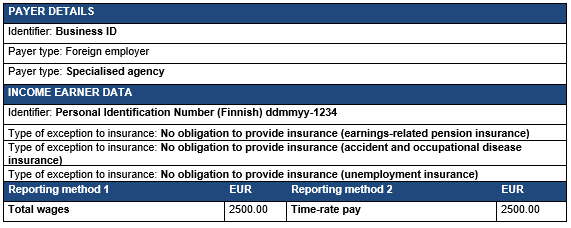
Example 41: The representative office of a foreign country in Finland pays an employee EUR 3,500 in wages. The employee is not a Finnish citizen. In Finland, she is covered by earnings-related pension, unemployment and accident and occupational disease insurance. However, the employee is not covered by the Finnish residence-based social security.
The payer reports the data to the Incomes Register by using the Type of exception to insurance data Not subject to Finnish social security (health insurance).
The data is reported to the Incomes Register as follows: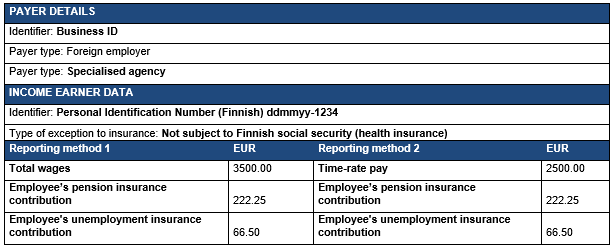
5.6 Non-wage compensation for work or compensation for use (royalty) paid to a non-resident taxpayer
Non-wage compensation for work or compensation for use (royalty) paid to an organisation
The payer must submit a report to the Incomes Register of the non-wage compensation for work paid to an organisation that is a non-resident taxpayer if tax at source has been collected from the non-wage compensation for work. The income is reported using the Non-wage compensation for work income type.
Compensation for use, or royalty, paid to an organisation that is a non-resident taxpayer (e.g. compensation paid for a copyright) must always be reported to the Incomes Register regardless of whether tax at source was collected from it or not. The income is reported using the Compensation for use, earned income income type.
When the payment is made to a foreign organisation, Organisation must also be specified as the type of additional income earner data. Furthermore, the income earner details must include the following data: Non-resident taxpayer: Yes.
Non-wage compensation for work or compensation for use (royalty) paid to a natural person
If the non-wage compensation for work or compensation for use (royalty) was paid to a natural person who is a non-resident taxpayer, the data must be reported to the Incomes Register even if no tax at source was collected from the payment. The non-wage compensation for work is reported using the Non-wage compensation for work income type, and the royalty using the Compensation for use, earned income income type.
The income earner details must include the following data: Non-resident taxpayer: Yes.
For more information, see the Tax Administration Guidelines, Paying non-wage compensation to a foreign company.
